駅訪問記 0
[街めぐり・神社めぐり] カテゴリの記事
全41件 (41件中 1-41件目)
1
-
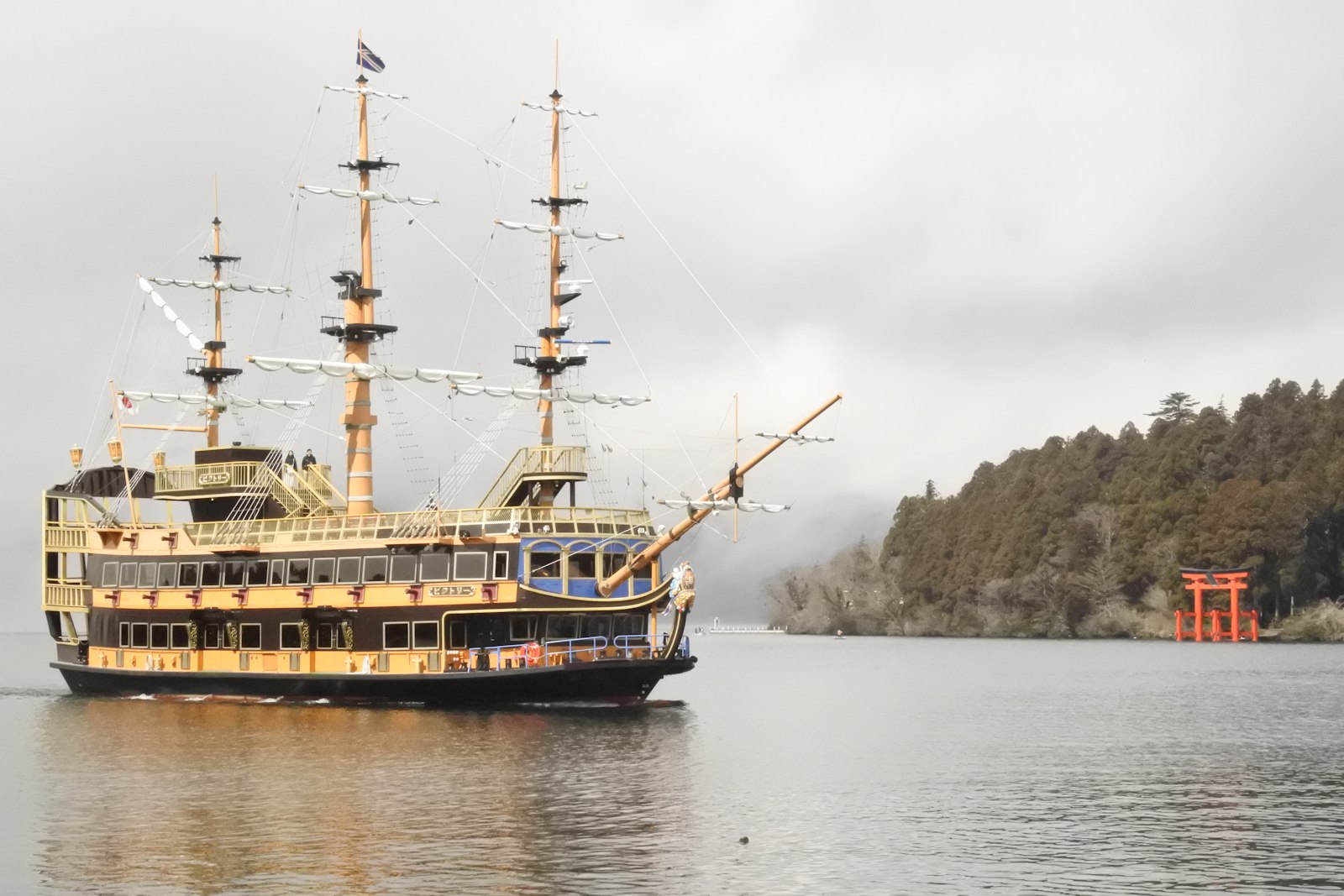
箱根海賊船・芦ノ湖遊覧船と平和の鳥居
芦ノ湖を航行する2つの船、箱根海賊船と芦ノ湖遊覧船を、湖上に浮かぶ箱根神社の「平和の鳥居」と共に撮影。芦ノ湖の箱根町・元箱根側の湖畔からは晴れの日には富士山も見えるのだが、この日は曇っていたことから見えなかった。1964(昭和39)年の初代海賊船「パイオニア」の就航から56年、その華やかな見た目が多くの観光客に人気の箱根海賊船。2020(令和2)年現在就航している海賊船は「ビクトリー」「ロワイヤルⅡ」「クイーン芦ノ湖」3種類あり、この日は「ビクトリー」と「ロワイヤルⅡ」の2隻が就航していた。写真は2007(平成19)年に就役した「ビクトリー」。一方2020(令和2)年に運航100周年を迎えた伊豆箱根鉄道が芦ノ湖遊覧船。2020(令和2)年現在「十国丸」「あしのこ丸」「はこね丸」「第二こま」の4種類の船が就航し、写真は「十国丸」。芦ノ湖は2019(令和元)年の台風19号(東日本台風)の時に、降り始めからの量が1000ミリメートルを超える観測史上最大の大雨によって氾濫し、箱根海賊船の乗り場が浸水するなどの被害があった。それから5カ月の時が経ち、芦ノ湖は普段通り箱根海賊船と芦ノ湖遊覧船が航行しており、平穏な日常を取り戻していた。I photographed the two ships, Hakone Sightseeing Cruise and Lake Ashinoko Pleasure Cruise, with a torii shrine gate on the lake. People could see Mt. Fuji from the lakeside, but I couldn't because of a cloudy day.Hakone Sightseeing Cruise, looking like pirate ships, is beloved by many tourists because of their gorgeous look since 1964. In 2020, three ships, "Victory" (in the first photograph), "Royal II", and "Queen Ashinoko" are in service.Lake Ashinoko Pleasure Cruise, having a longer history than Hakone Sightseeing Cruise, marks its 100th anniversary in 2020. "Jikkoku-maru" (in the second photograph), "Ashinoko-maru", "Hakone-maru", and "Koma II" are in service.In 2019, Typhoon Hagibis caused a flood of the lake and the damage of some ports. About five months later, the lake backed on safe ground.
Mar 15, 2020
コメント(0)
-

21年ぶりの北海道 函館の夜景を眺める
函館の夜を迎えた。せっかく函館へ来たのだから、中国・香港のヴィクトリア・ピーク、イタリア・ナポリのポジリポの丘のものと共に世界三大夜景の1つに数えられる、函館山の山頂展望台から臨む夜景を見ないわけにはいかない。函館市電の十字街電停から南部坂を上がって函館山ロープウェイの山麓駅へ。3分ほど乗車して山頂駅へ。山頂駅の外に出ると、美しい夜景が広がる展望台へ。まずは定番の函館の街並み全体を入れた写真を1枚撮影。これだけではもの足りず、せっかくだから、僕らしい夜景写真を撮ろうと思い、函館市電を入れた1枚を撮影。海峡通の魚市場通電停~十字街電停を走る電車を捉えた。函館山の夜景は21年前にも見たのだが、やはりその美しさは前回と変わっていなかった。展望台から函館市電本線が走る海峡通が見えたことから、市電を入れた夜景の写真を一度撮ってみようと思った。On the night of the first day, I went seeing the night view from the top of Mt. Hakodate, which is listed on the three best night views as well as Victoria Peak in Hong Kong, China and Posillipo Hill in Naples, Italy, and the best attraction in Hakodate.Going up Nambu-zaka Slope from Jujigai Stop on Hakodate City Tram and travelling with Mt. Hakodate Ropeway (aerial tramway), I came to the observation deck, from which you could see the beautiful night view.The first photograph is the night view of whole Hakodate City, looking in ordinary composition and resembling those on magazines or websites for tourists.The second is that featuring a tram running on Strait Avenue between Uoichiba-dori [Hakodate Fish Market Street] Stop and Jujigai Stop.I felt the beauty of the view is unchangeable.
Sep 14, 2019
コメント(0)
-
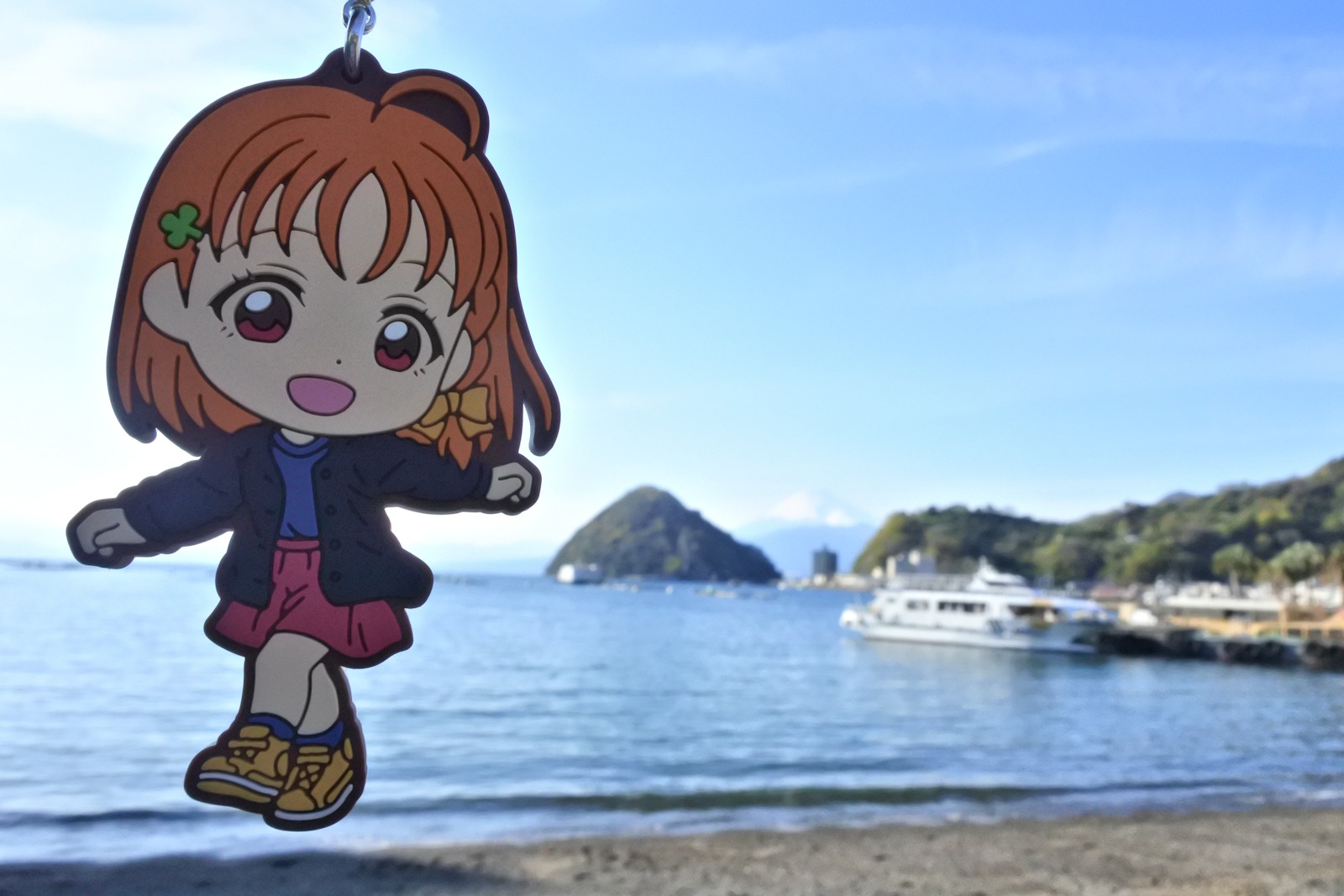
花見の「静岡デスティネーションキャンペーン」 ちょっとだけ三津浜巡礼
「富士山満喫トレイン」撮影後は、再びJR東海御殿場線の各停列車で沼津駅へ。せっかく沼津へ来たのだから、「ラブライブ!サンシャイン!!」の舞台となった内浦地区へ寄り道したい。しかも「ふじのくに家康公きっぷ」のフリーエリアには、東海バスオレンジシャトルの沼津駅南口バス停~伊豆三津シーパラダイスバス停間が含まれているのだから、行かない手はない。僕は沼津駅南口バス停から東海バスオレンジシャトルN22系統に乗って三津浜へ。しかも来た車は、3台在籍する「ラブライブ!サンシャイン!!」ラッピングバスのうちの1台である800号車であった。ドアが開くと車外スピーカーから聞こえてきたのは、同作の主人公、高海千歌ちゃん役の声優・伊波杏樹さんの声によるアナウンス。沼津駅南口バス停発車後と内浦地区(栽培漁業センターバス停~長井崎中学校バス停間)走行中の車内アナウンスも伊波さんの声が使われている。車内ポスターも「ラブライブ!サンシャイン!!」のもので揃えられており、同作の舞台である内浦地区へと向かうワクワク感を高めてくれる。バスに乗ること約40分、「ラブライブ!サンシャイン!!」の舞台である内浦地区・三津浜にある、沼津駅南口バス停からの東海バスオレンジシャトルにおける「ふじのくに家康公きっぷ」のフリーエリアの終端でもある伊豆三津シーパラダイスバス停に到着。まずは三津浜を象徴する景色である三津海水浴場から臨む内浦湾、淡島、そして富士山を撮影。続いて、三津海水浴場の道を挟んだ向かい側にある安田屋旅館を。ここは作家の太宰治先生が滞在中に「斜陽」の第1章と第2章を執筆した宿として有名である。「ラブライブ!サンシャイン!!」の作中では、高海千歌ちゃんの実家として描かれている。短い時間ではあったが、再び三津浜へ行くことができて良かった。今回は特に、三津海水浴場から見た富士山が、ものすごく素晴らしく印象的だった。次行く時は、じっくりと三津浜の景色を眺めていたい。After photographing "Mt.Fuji Mankitsu Train", I went back to Numazu Station by JR Central Gotemba Line. Because of coming to Numazu, I would like to visit Mitohama Area, which is set in "Love Live! Sunshine!!" anime or a smartphone game. Moreover, the ticket which I had could be available to travel to Mitohama by Tokai Bus Orange Shuttle, which made me want to go there.Luckily for me, one of three buses having the livery of the anime, no. 800, toward Mitohama, had come.As the door of the bus opened, an announcement by Anju Inami, who is the voice actress and cast as one of the nine main characters, Chika Takami, from the anime, was performed over the outside speaker. The announcements by her were also done when the bus departs from the Numazu Station Bus Stop and runs in Uchiura Area, including Mitohama. The interior advertisements are only the ones from the anime, which made me excited more while travelling to Uchiura.Taking about 40 minutes, the bus came to Izu-mito Sea Paradise Bus Stop, which is the end of the designated area for the unlimited travel of the ticket along with the Tokai Bus Orange Shuttle from Numazu Station.First, I photographed Mt.Fuji and Awashima Island over Uchiura Bay from Mito Beach.Next, I did Yasudaya Inn, which is located right across the street from the beach and famous for where a Japanese novelist, Osamu Dazai, stayed to write the first and second chapter of "The Setting Sun". In "Love Live! Sunshine!!" anime, the inn is pictured as the house of Chika's.Though I could visit there in a very short time, I re-realised the beautiful scenery in Mitohama. Especially at that time, I was attracted by Mt.Fuji over the bay. I would like to visit for a more long time there.
Apr 13, 2019
コメント(0)
-
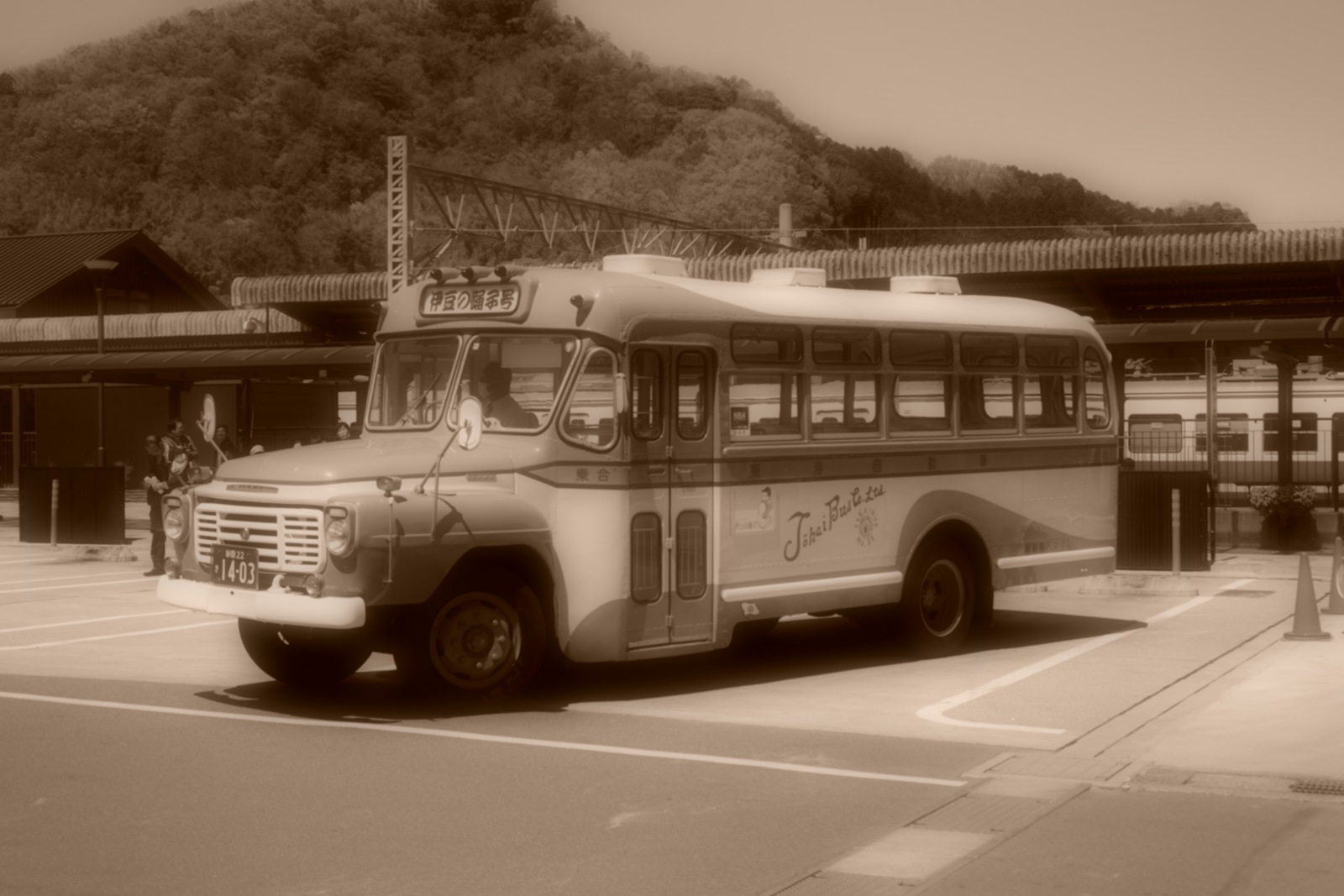
花見の「静岡デスティネーションキャンペーン」 ボンネットバス「伊豆の踊子号」
この日修善寺駅に来た理由は、伊豆箱根鉄道駿豆線の列車撮影以外にもう1つある。新東海バスのボンネットバス「伊豆の踊子号」である。1964(昭和39)年に製造されたいすゞ自動車・BXD30というタイプの車であり、1976(昭和51)年より観光路線バスとして活躍している。近年は貸切用となり、路線バスとしてはほとんど運行されなくなったが、「静岡デスティネーションキャンペーン」の一環として、4月の土日・祝日に修善寺駅バス停~修善寺温泉バス停間を臨時便として特別運行されている。僕はボンネットバスが主役だった時代を知らないが、数少ない現役で走っているボンネットバスを見ることができるとだけあって、当時の雰囲気を少しばかりでも感じたいとその姿を見てきた。時代は21世紀となり、平成から令和へと移り変わろうとしているにもかかわらず、55年前から変わらない姿を保っている「伊豆の踊子号」を、現代的なカラー写真のほか、ボンネットバス全盛期と言えるであろう昭和30~40年代頃の雰囲気を醸し出すセピア色写真の2種類を撮影した。車庫から修善寺駅バス停へとやってきた「伊豆の踊子号」 "Izu no Odoriko" bus coming to the bus terminal of Shuzenji Station案内所付近の乗り場にいったん入る stopping near the information counter本来の乗り場へと移動する Going to a stop for the bus toward Shuzenji Hot Spring修善寺駅バス停で乗客が来るのを待つ Waiting for the passengers「伊豆の踊子号」のサボ The sign board on its side beside the doorI had one more reason why coming to Shuzenji, which was to see and shoot photographs of bonnet-style bus "Izu no Odoriko"."Izu no Odoriko", named after a Japanese novel written by Yasunari Kawabata, "The Dancing Girl of Izu", is a Isuzu BXD30 type bus made in 1964 and has been in service for the tourists since 1976. Recently, the bus is almost in chartered service and retired from regular service, but on Saturdays, Sundays, and holidays in April, 2019, the bus is in special service between Shuzenji Station and Shuzenji Hot Spring as a part of "Shizuoka Destination Campaign".Though I didn't live in the time that many bonnet-style buses in service, I would like to see the one directly.I shot some pictures of the bus not only in full colour, but also in sepia to create a nostalgic atmosphere.
Apr 13, 2019
コメント(2)
-
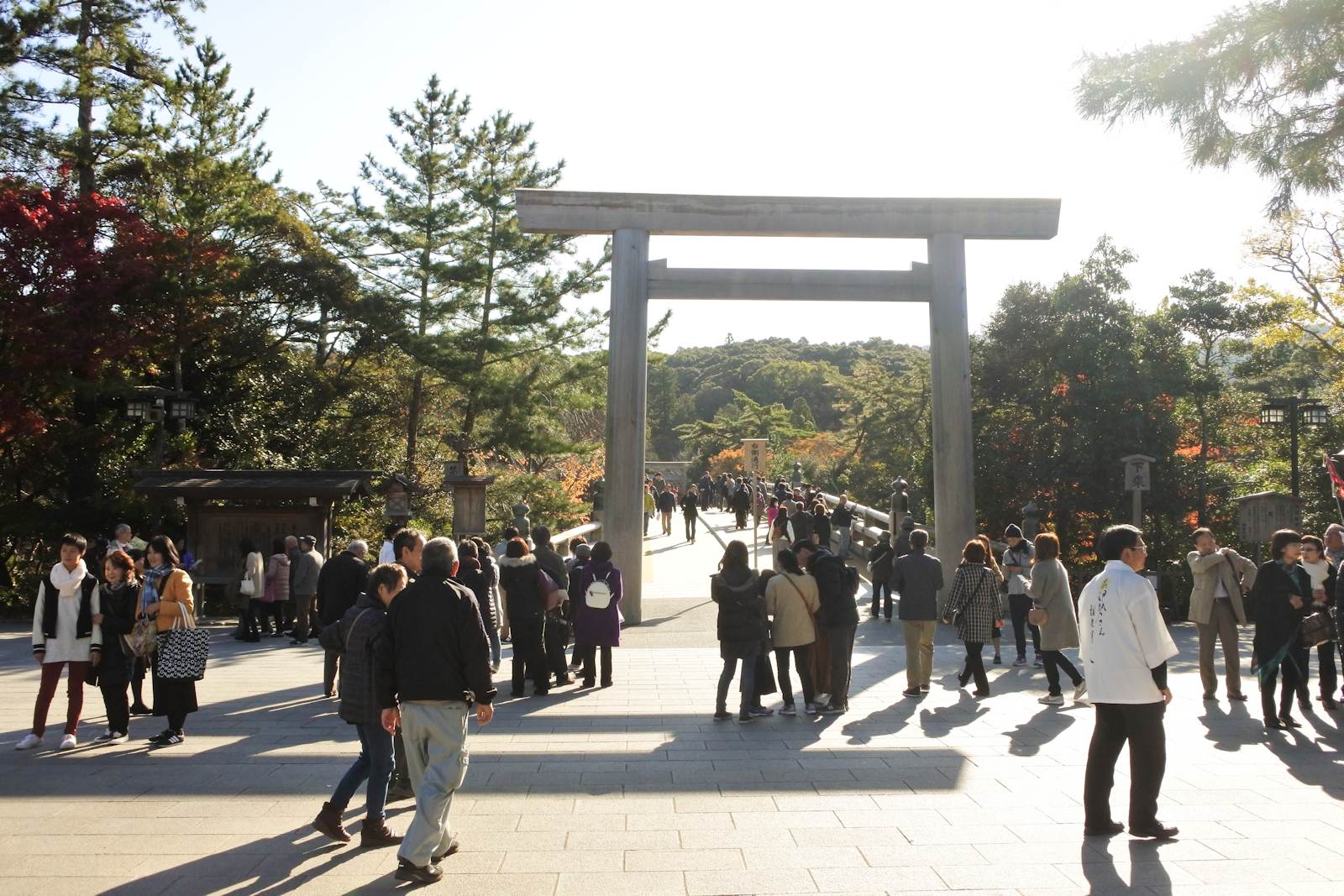
初めてのお伊勢参り 内宮
僕の初めてのお伊勢参りは2日目。この日は内宮を参拝した。内宮の正宮である皇大神宮は、皇族のご先祖様である天照大御神様をお祀りする神社。今から2000年ほど前の垂仁天皇26年に建立された。謂れは、それまで宮中(天皇のお住まい)で祀られていた天照大御神様を祀る新しい場所を探して旅をしていた垂仁天皇の皇女(娘)・倭姫命に、天照大御神様が「常世の国からの波が繰り返し繰り返し押し寄せる地であり、辺境ではあるが美しい国であることから、私は伊勢に住まいたい」と告げられたことによる。天照大御神様がおっしゃる「常世の国からの波が繰り返し繰り返し押し寄せる地であり、辺境ではあるが美しい国」とは、伊勢が古代日本人が海の向こう側にある考えていた不老不死の世界のことであり、時として死後の世界「黄泉の国」であるとも解釈された「常世の国」に最も近い場所であるということ。お告げに従った倭姫命が五十鈴川の畔に、天照大神様を祀る斎宮(いわいのみや)を創建した。この斎宮が内宮の原型である。神都バスを降りて真っ直ぐ進むと、全日本大学駅伝対校選手権大会のゴールとしてもとしても知られるロータリーの左側に、内宮への入口である鳥居と五十鈴川に掛かる宇治橋が見える。橋の上から川を眺めると、上流方向の山々が色あざやかに紅葉し始めていた。橋を渡り終えて境内に入る。この先も川に沿って歩を進める。先ほど橋の上から見えた紅葉を正面に見ながら正宮へと向かう。内宮には手水舎とは別に、五十鈴川のせせらぎに直接手を浸して浄める御手洗場(みたらしば)という場所もある。そこから見えた川沿いの紅葉も美しかった。御手洗場から川と別れ、千古の森を通り過ぎると、正宮が見えてきた。祀られている天照大御神様は、「日本書紀」において「輝くこと明るく美しく、天地四方の隅々まで照り輝いた」天界(高天原)の統治者として、また東征中の神武天皇一行に対して、武甕槌(タケミカヅチ)を救援に送ろうとしたり、八咫烏(ヤタガラス)を派遣して導いたりする場面が描かれている。日本中に太陽の恵みを与えてくださる神様であり、人々が困難に直面した時には救いの手を差し伸べてくださる神様でもある。内宮の正宮は「興梠組(きょうろぐみ)」と呼ばれる構造で、千木は水平に切られた内削、鰹木は10本。子孫である皇族の方々だけでなく、日本人全員にとっての総氏神である尊い存在、天照大神様を祀る「日本人の心の故郷」と言われる神社として、今日までその簡素ながらも神々しい姿を残している。その尊さを身に染みたような感覚を覚えながら、正宮をお参りした。もちろんここ内宮でも、神域内の別院である荒祭宮も併せてお参りした。参拝後は、お伊勢参りに来たならば神宮と共に訪れたいおはらい町通りとおかげ横丁へ。石畳が敷き詰められた通りに、切妻・入母屋・妻入り様式の昔ながらのたたずまいを残す飲食店やみやげ物店が立ち並ぶおはらい町通りと、そのおはらい町通りの中間地点付近から分かれて江戸時代から明治年間に建てられた建築物を再現・移築したおかげ横丁を、伊勢エビコロッケバーガーや豆腐のソフトクリームを買って、食べ歩きした。昼食には伊勢うどんを食べた。On the second day of my first visiting Ise Grand Shrine, I visited Naiku.The Shogu of Naiku, Kotai Jingu, enshrines Amaterasu Omikami, the ancestor of Imperial family, and established in the era of Emperor Suijin, about 2000 years ago."Chronicles of Japan" said that the princess of Emperor Suijin, Yamatohime, travelled to seek where Amaterasu had been newly enshrined on that time, and heard that Amaterasu had decided to enshrine herself and worship in Ise because the waves from utopia named "Tokoyo no Kuni", which is believed to exist over the ocean by Japanese people and sometimes be construed as the after-life named "Yomi no Kuni", had come and the beautiful nature surrounded. Yamatohime had followed what Amaterasu said and constructed a shrine for Amaterasu named "Iwai no Miya" along Isuzu River, the origin of the Grand Shrine.Walking straight from the bus stop of Shinto Bus, I came to a roundabout which a torii gate with Uji-bashi bridge faces and is also known as the goal of All Japan University ekiden relay racing. From the bridge, mountains over the river began to turn colour.From the end of the bridge, the approach to Shogu runs in parallel with the river and toward the mountains. While walking, I saw the green- and red-coloured mountains.In addition to cleansing at chozuya, I tried to cleanse their body and mind at Mitarashiba, where persons can directly immerse their hands in river water. The leaves from Mitarashiba was also beautiful.Following the approach, the way to Shogu turn left and separate from the river. Walking in a forest, I could see Shogu.In "Chronicles of Japan", Amaterasu is drawn as the deity the ruler of Takamanohara, where deities live, who gives sunshine all over Japan, and help and advice honest persons.The Shogu building of Naiku is built with the method called Kyorogumi structure and its Chigi projecting bargeboards from beyond the roof is cut horizontally (Uchisogi) and ten Katsuogi billets on the ridge of the roof.I also dedicated a betsugu in the sanctuary Aramatsurinomiya.After going out of the sanctuary, I also visited Oharai-machi Street and Okage Yokocho district, where relocated classic buildings and aesthetic buildings used as souvenir shops, restaurants, and cafes are located. I ate hamburger and twisted icecream tofu while walking along and Ise Udon noodles on lunch time.参考文献・資料 References伊勢神宮 オフィシャルWebサイト伊勢神宮 パンフレットIse Grand Shrine brochureコトバンク 倭姫命コトバンク 常世の国日本神話.com伊勢市観光協会 Webサイト
Nov 25, 2017
コメント(0)
-
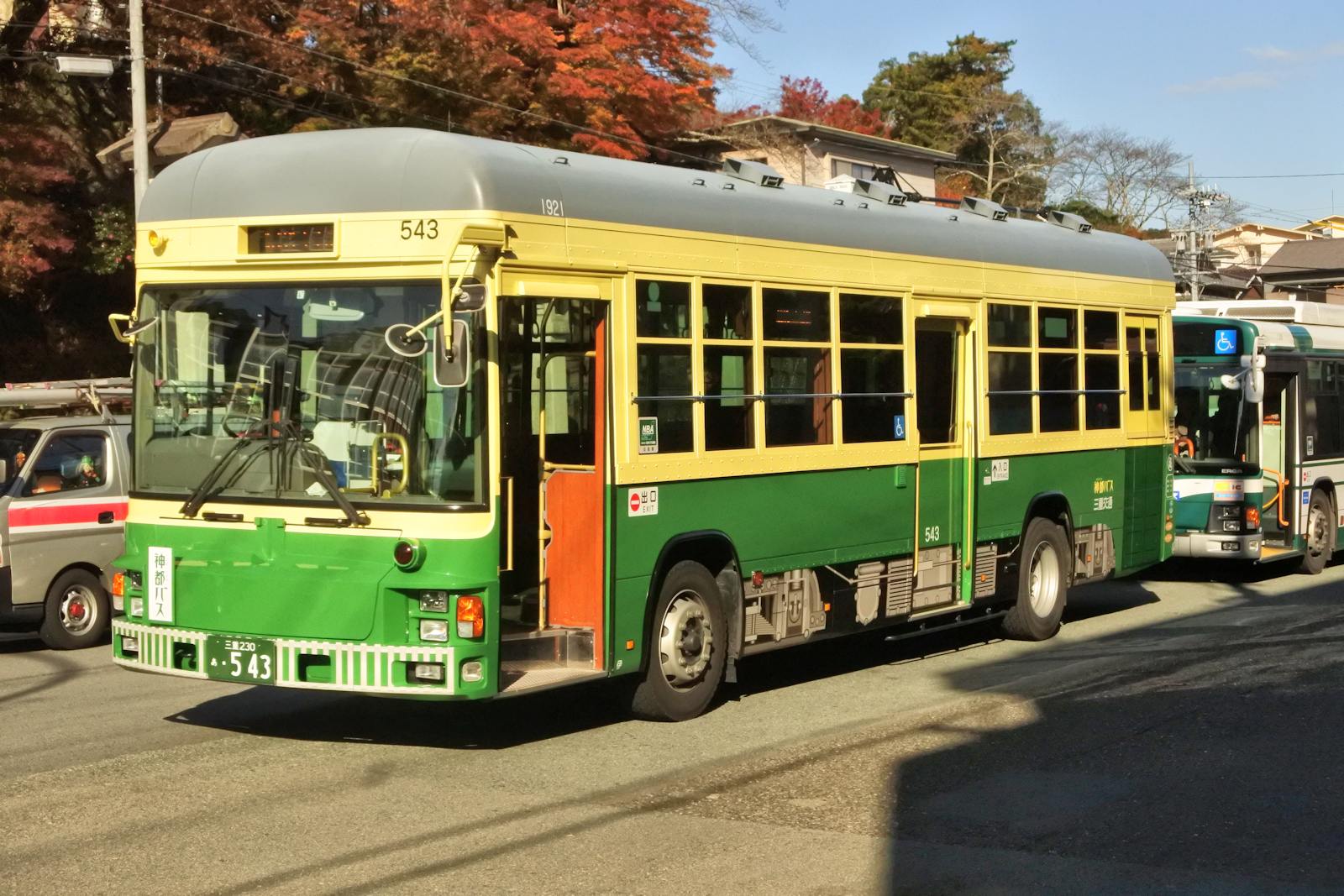
「神都バス」で内宮へ
伊勢神宮参拝2日目は、内宮を参拝する。伊勢市駅前から内宮へは、内宮前行きの三重交通バスに乗車した。今回乗ったバスの車両は、かつて伊勢市内を走っていた路面電車、三重交通神都線を走っていたモ541形車両をイメージした車、「神都バス」。この神都バスはジェイ・バス製の車をベースに、車体を東急テクノシステムで改造したもの。かつての神都線と同様に、伊勢神宮内宮・外宮と宇治山田駅・伊勢市駅を結んでいる。車内も路面電車の車両のような雰囲気で、最後部を除いてロングシート。さらにバス停を発車する直前に、本物の路面電車よろしく「チンチン」というベルの音が流れる。車内にはかつての神都線の写真を使ったポスターが貼り出され、当時の様子をうかがい知ることができる。車体の塗装はもちろんのこと、側面には台車や制御機器類まで描かれ、屋根にはトロリーポール(飾りであり、実際に電気を動力とするわけではない)が取り付けられている。後面も路面電車の3枚窓風となっている。神都線は1903(明治36)年に宮川電気鉄道の手により、1914(大正3)年までの間に山田駅(現在の伊勢市駅)~内宮間が開業した。伊勢神宮の周辺の町が「神都」と呼ばれたことから神都線の名が与えられた。のちに神都線は運営する事業者をころころと変えながら、1944(昭和19)年より三重交通の路線となり、1961(昭和36)年まで営業を続けた。明治時代に、参宮鉄道(JR東海参宮線の前身)とともに伊勢神宮参拝客の移動の近代化に貢献した路面電車である。On 25th, while going to Naiku shrine, I travelled by Mie Kotsu's Shinto Bus, whose exterior and interior looks like those of late tram car in Ise City, Shinto Line.It was converted by Tokyu Techno System based on a bus manufactured by J-BUS and its floor, roof, and walls are timber tone and its sheetings except reer ones are longitudinal. Before departing from bus stops, a bell rings twice. The posters of old photograph of Shinto Line tram car are shown in the bus.Its exterior is not only painted looking like the tram car, but the bogies and equipment are done and a dummy trolley pole is set on its ceiling. Its back also looks like that of the tram car.Shinto Line opened in 1903 and had been extended to Naiku in 1914; it had connected between Yamada Station (present Iseshi Station) and Naiku via Geku. It had been named after nickname of town around Ise Grand Shrine "Shinto (capital of dedication)". It had changed its operator and Mie Kotsu had started the business between 1944 and 1961. Together with JR Central Sangu Line, Shinto Line modernised the travel between Iseshi Station and the shrines.参考文献・資料 Reference伊勢志摩における観光開発の展開と経済的効果三重交通 オフィシャルWebサイト
Nov 25, 2017
コメント(0)
-
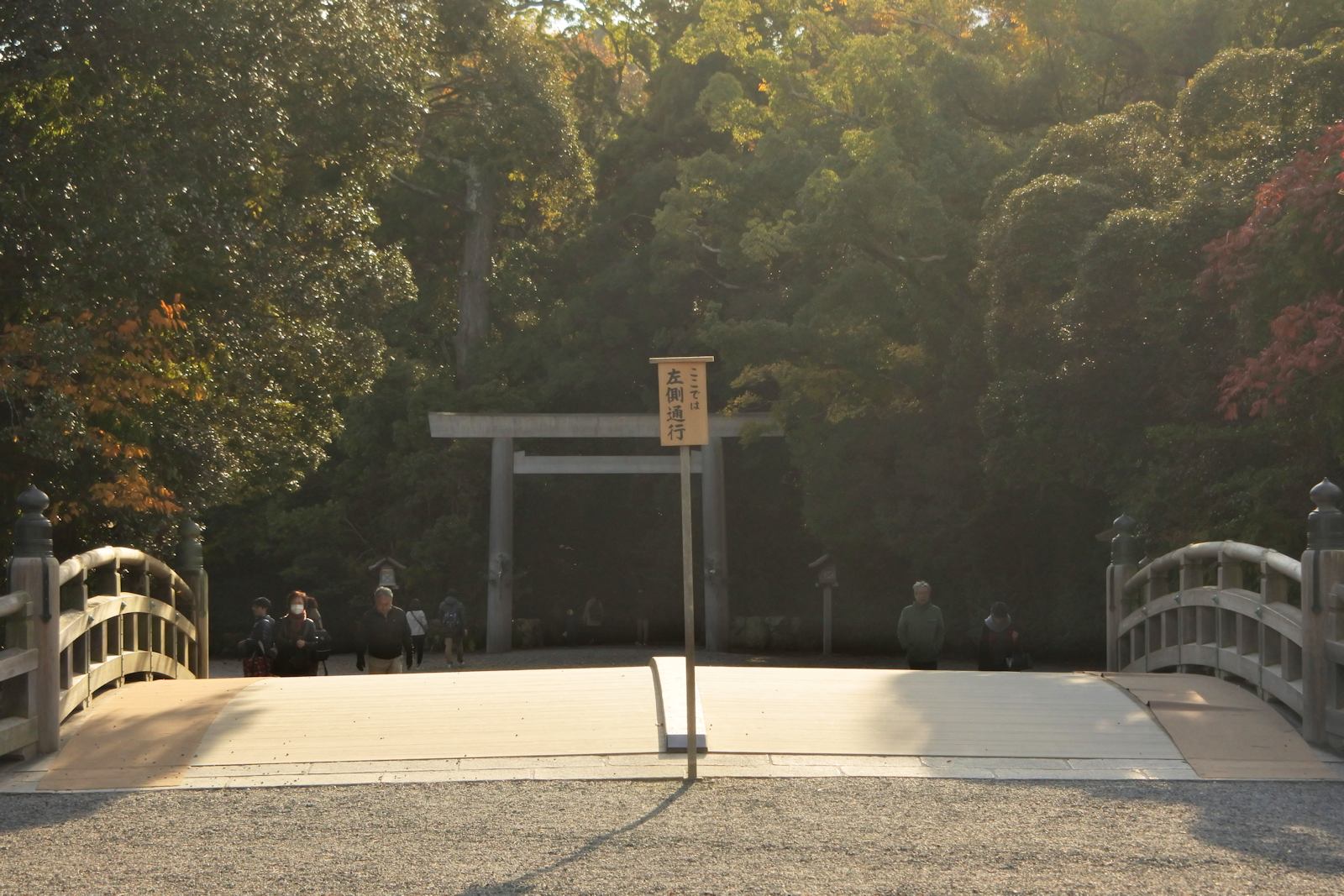
初めてのお伊勢参り 外宮
伊勢市駅で「伊勢志摩ライナー」を降り、いよいよ今回の旅の1つめの楽しみ、伊勢神宮を参拝する。伊勢神宮は日本の総本社とされる神社で、大きく外宮と内宮の2社に別れている。それらに加えて、伊勢市内とその周辺の市町に123の別宮・摂社・末社・所管社から構成されている。正式名称は単に「神宮」であり、熱田神宮や明治神宮など全国の「○○神宮」と呼ばれる神社との区別のために「伊勢神宮」と、また親しみを込めて「お伊勢さん」と呼ばれている。外宮は内宮に祀られている天照大御神様の食事を司っていた神様(御饌都神(みけつかみ))で、衣食住と産業の守り神でもある豊受大御神(トヨウケビメ)様をお祀りする豊受大神宮を正宮とする神社。1500年ほど前の雄略天皇22年に建立された。謂れは、「止由気宮儀式帳(とゆけぐうぎしきちょう)」や「豊受皇太神御鎮座本紀(とようけこうたいじんごちんざほんぎ)」によると、雄略天皇の夢に天照大御神が現れて、「私一人では食事が安らかにできないので、丹波国比治の真名井(ひじのまない 現在の京都府宮津市にあたる)にいる私の御饌都神、豊受大御神様を、私の近くへ連れてきてください」という内容のお告げをお聞きになられ、夢から目覚められた天皇が、豊受大御神様を丹波国からお呼びになり、度会の山田原(やまだのはら 現在の三重県伊勢市)に立派な宮殿を建て、お祀りになられたという。この日は伊勢市駅前から伸びる参道から外宮をお参りした。伊勢神宮では外宮から内宮への順番で参拝するのが礼儀であり、僕もその礼儀に則って参拝することにした。伊勢市駅のJR東海参宮線ホーム側の改札口を出て、駅前に立つ鳥居をくぐった先に伸びる参道を道なりに真っ直ぐと進むと、外宮へとたどり着く。表参道火除橋を渡り、外宮境内へと入る。橋の先の手水舎で手と口を浄めて正宮へと向かう。正宮の手前には「古殿地(こでんち)」と呼ばれる、正宮が立地する土地とほぼ同じ大きさの更地がある。ご存知の方も多いと想像するが、伊勢神宮では20年に一度、社殿をそっくりそのままの形で別の場所へと建て替える「式年遷宮」が行われている。古殿地は式年遷宮の際に新しい社殿が建てられる土地である。伊勢神宮の社殿は「唯一神明造」と呼ばれる建築様式で、萱葺き屋根とヒノキの素木を使用した柱が特徴の簡素な造り。柱には礎石がなく直接柱が地面と接している。内宮と外宮では、正宮の屋根の破風から延びる千木の切り方や、萱葺き屋根の上に置かれた鰹木の本数に細かな違いが見られ、外宮の正宮は「折置組(おりおきぐみ)」と呼ばれる構造で、千木は垂直に切られた外削、9本の鰹木が置かれている。正宮をお参りした後は、神域内の別院である土宮、風宮、多賀宮も併せて参拝した。続いて表参道火除橋近くにある勾玉池を休憩所の窓から眺めた。池の中には舞台があり、毎年9月に開催される神宮観月会や秋の神楽祭などの年中行事において、舞や音楽の演奏が披露される。表参道火除橋を渡り一度境内の外へ出るものの、外宮参拝はこれで終わりではない。正宮の神域から北へ400mほどに位置する外宮の別宮、月夜見宮を参拝する。月夜見宮は天照大御神様の弟神である月夜見尊様と、その月夜見尊様の荒御魂(あらみたま)をお祀りしている。荒御魂とは、和御魂(にぎみたま)と呼ばれる神様の穏やかな姿に対して、時として現れる特別な神威に満ち溢れた姿を言う。ここにも͡正宮と同様に社殿の隣に古殿地があり、式年遷宮の際にこちらに社殿が移築される。これで外宮の参拝は終わった。翌25日は内宮を参拝する。Getting off "Ise Shima Liner"at Iseshi Station, I worshipped at Ise Grand Shrine, one of the well-known Shinto shrines.Ise Grand Shrine, officially called "Jingu", mainly consists of two main shrines in Ise City, "Kotai Jingu" ("Naiku") and "Toyouke Dai-jingu" ("Geku") and 123 small shrines called "Betsugu", "Sessha", "Massha", or "Shokansha" located around the two or in surrounding area. The shrines are also affectionately called "Oise-san" by Japanese people.Toyouke-omikami, the deity of agriculture, rice harvest, and industry, and who managed the foods served for Amaterasu, the deity who is enshrined at Naiku, is enshrined. It was established about 1500 years ago.Japanese ancient writings, "Toyukegu Gishikicho (notes of celemonies at Geku)" and "Toyouke-kotaishin Gochinza Honki (notes of Geku about history, relationship with Naiku, and celemonies)", says the 21st Emperor Yuryaku dreamed Amaterasu telling him that he brought Toyouke along nearby from Hiji-no-manai, north of Kyoto Prefecture, because Amaterasu couldn't live her comfortable life without Toyouke. The Emperor built a shrine to let Toyouke dwell in Yamadanohara, near where Amaterasu is enshrined.On that day, I visited Geku shrine located in near the station because it is a manners when visiting the shrines that people visit Geku first and Naiku second. Getting through a Torii gate in front of the station and walking straight on a shopping street until the end, I came in front of Geku.Crossing Omote-sando Hiyoke-bashi Bridge, sanctuary starts.Cleansing my hands and mouth at chozuya, I walked along the approach to Shogu shrine building.Before coming to Shogu, a empty site as large as that where Shogu stands called "Kodenchi" is laid out. Ise Grand Shrine holds an big event every 20 years; those buildings in the shrines are rebuilt and move to the adjacent site, known as "Shikinen Sengu". It is a land for the rebuilding of Shogu.The shrine buildings are constructed in Yuitsu-shinmei-zukuri style, characterised by structure made of plain wood of Japanese cypress and thatched roof. The pillars are directly set on the ground. There are some small differences between those in Naiku and Geku, such as way of cut of the end of Chigi projecting bargeboards from beyond the roof, Naiku is horizontally (Uchisogi) and Geku is vertically (Sotosogi), the number of Katsuogi billets on the ridge of the roof, Naiku is ten and Geku is nine. Shogu building of Geku is built with the method called Oriokigumi structure. I also dedicated three betsugu in the sanctuary, Tsuchinomiya, Kazenomiya, and Takanomiya.While going back to the Omote-sando Hiyoke-bashi Bridge, I viewed Pond Magatama from the rest pavilion over the window. Above the pond, a stage is laid out, on which dance and music performance are given on the day of some annual events.Crossing the bridge and going out of the sanctuary, I walked northward to visit another betsugu, Tsukiyominomiya, which enshrines Tsukiyomi, younger brother of Amaterasu.Next to its shrine building, kodenchi is also laid out and the building also iterates dismantlement and rebuilding.The first day of my visiting ended. On the following day, I would do Naiku.参考文献・資料 References伊勢神宮 オフィシャルWebサイト伊勢神宮 パンフレットIse Grand Shrine brochureコトバンク 止由気宮儀式帳コトバンク 《豊受皇太神御鎮座本紀》
Nov 24, 2017
コメント(0)
-
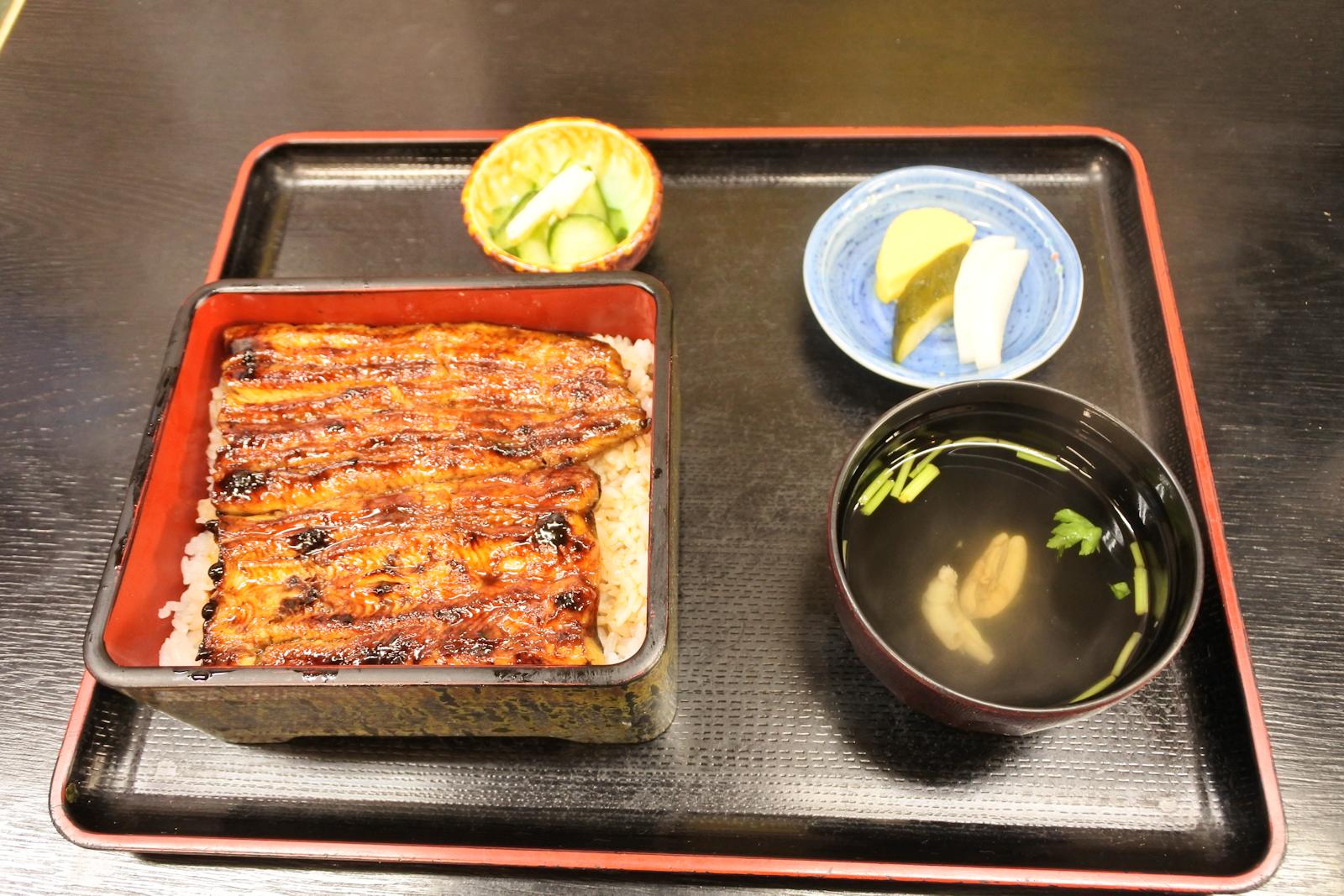
「二の丑」の日は三島のウナギで
ウナギが三島の名物であることと、ちょうどこの日8月6日が夏の土用の「二の丑」の日ということから、ウナギを頂くことにした。今回訪ねたのは、三島駅にほど近い「不二美」というお店。静岡県でウナギといえば、浜松市の浜名湖のウナギを想像する人も多いと思われるが、三島市もウナギが名物となっている。三島のウナギのおいしさの秘密は、富士山の湧水で活きじめにしている点。ミネラルが豊富な富士山の湧水で、餌を与えずに数日~1週間程ウナギを泳がせることで、余分な脂が落ち、臭みも取れる。そこから、しつこくないすっきりとした味で、ふっくらと焼きあがるということだそうだ。実際に食べてみたところ、脂っぽくなく臭みも感じず、タレの風味との組み合わせも程よいもので、少なくとも僕の味覚では美味しいウナギだと感じた。My lunch on 6th was a jubako box of rice topped with grilled eel because of a famous food in Mishima City, Shizuoka, and the day that eating eel makes people more healthy to survive the hot summer in Japan. Where I stop over was "Fujimi" located near Mishima Station.In Shizuoka Prefecture, the most well-known city famous for eel is Hamamatsu, but Mishima is also.The most important point of the taste of eel in Mishima is throwing eels into the water from Mt. Fujifor up to one week without feeding to get rid of excess fat and fishy smell, which creates its non-oily and soft taste.While eating, I felt the eel tasted so and matched its sauce. In my opinion, I felt it was a delicious eel.参考資料 Reference三島市オフィシャルサイト 「三島アメニティ百科 名水から生まれた食」icotto 富士の湧き水で鰻が美味しい!静岡・三島のうなぎ専門店6選
Aug 6, 2017
コメント(0)
-

初めての西伊豆 初めての内浦
伊豆の旅2日目の6日は、「ラブライブ! サンシャイン!!」の舞台となった沼津市の内浦へ。僕はこれまでにも伊豆を旅したことは何度かあるが、伊豆急行線が走る相模湾側の東伊豆、伊豆箱根鉄道駿豆線が走る内陸部の中伊豆とは対照的に、駿河湾に面した西伊豆には鉄道路線が存在しないためか、今まで僕は西伊豆を旅することがなかった。伊豆長岡駅から伊豆・三津シーパラダイス行きの伊豆箱根バスに揺られること約25分、伊豆箱根鉄道運営の水族館、伊豆・三津シーパラダイスに到着。「みとしー」の愛称で呼ばれる伊豆・三津シーパラダイスの特徴といえば、水族館としての規模は小さめなものの、駿河湾の入り江という地形を活かした、海水でのイルカ・アシカ・オットセイなどの飼育と、日本一の水深を誇る駿河湾に生息する深海魚の展示と言える。2017(平成29)年に開館(正確には前身である三津天然水族館からのリニューアル・改称)から40周年を迎え、館内に伊豆の川やワサビ田をイメージした「イズリバ」など、新しい施設・展示が増えたことからも、注目されている。駿河湾の海水を利用した「イルカの海」でのイルカショー 駿河湾沿いの街と駿河湾に浮かぶ淡島を背景にジャンプするイルカ Dolphin performance at a seawater pool against town in Uchiura area and Awashima Island伊豆・三津シーパラダイスを楽しんだ後は、同水族館から程近い安田屋旅館へ。この旅館は、文豪・太宰治先生が泊まり込み、「斜陽」の第1章と第2章を執筆した宿として知られる。「ラブライブ! サンシャイン!!」の作中では、メインキャラクターの1人、高海千歌ちゃんの実家のモデルとして描かれている。創業は1887(明治20)年で、1918(大正7)年建築の松棟と1931(昭和6)年建築の月棟は、2000(平成12)年に国の登録有形文化財に指定されている。太宰治先生が泊まった松棟の「松の弐」の間は、現在も「月見草の間」として残されている。旅行サイトの安田屋旅館の紹介ページに、喫茶スペースの利用だけでもぜひどうぞと書かれていたことから、僕は喫茶スペースに上がり、アイスティーを1杯頂いた。最後に、伊豆・三津シーパラダイス、安田屋旅館を入れて、内浦三津の街を走る伊豆長岡駅へと向かう伊豆箱根バスと沼津駅へと向かう東海バスオレンジシャトルを撮影。帰りは伊豆箱根バスで伊豆長岡駅へ戻るのではなく、駿河湾の景色を見ながら沼津駅行きの東海バスオレンジシャトルに乗った。そして、沼津駅では驚きの出会いが待っていた…。On 6th, the second day of my travel in Izu, I travelled around Uchiura, Numazu City, where "Love Live! Sunshine!!" anime is set.Though I have travelled east caust and middle area of Izu Peninsula several time, It was first time for me to travel in west caust because no railway line spreads in the west caust.First, I visited Izu Mito Sea Paradise, the aquarium managed by Izu Hakone Railway. It takes about 25 minutes by bus from Izu-nagaoka Station.The attractions of the aquarium are the seawater pools for dolphins, seals, and fur seals to utilise the cove and abyssal fish living in Suruga Bay, the deepest bay in Japan. In 2017, the aquarium marked the 40th anniversary of its refurbishment and change its name, and new exhibitions and attractions, such as "IZU RIVER" inspired by river and horseradish field in Izu.After enjoying the aquarium, I dropped into Yasudaya Ryokan inn located near the aquarium. The inn opened in 1887 and is famous for where Osamu Dazai stayed and wrote Chapter 1 and 2 of "Setting Sun" while his stay. The room he stayed, named "Tsukimiso (oenothera tetraptera)", still remains. The two buildings, "Matsu-to", built in 1918, and "Tsuki-to", built in 1931, have been listed in National Cultural Assets.It is also known as the inspiration for one of the main nine girls, Chika Takami’s home in "Love Live! Sunshine!!" anime.Because websites introducing the inn said that it welcomes persons only for drink at lobby, I drank a cup of tea.At last, I photographed a Izu Hakone Bus for Izu-nagaoka Station and a Tokai Bus Orange Shuttle for Numazu Station against the aquarium and the inn.When going back, I chose Tokai Bus Orange Shuttle seeing the bay from the window. Then, At Numazu Station a something unexpected happened...
Aug 6, 2017
コメント(0)
-
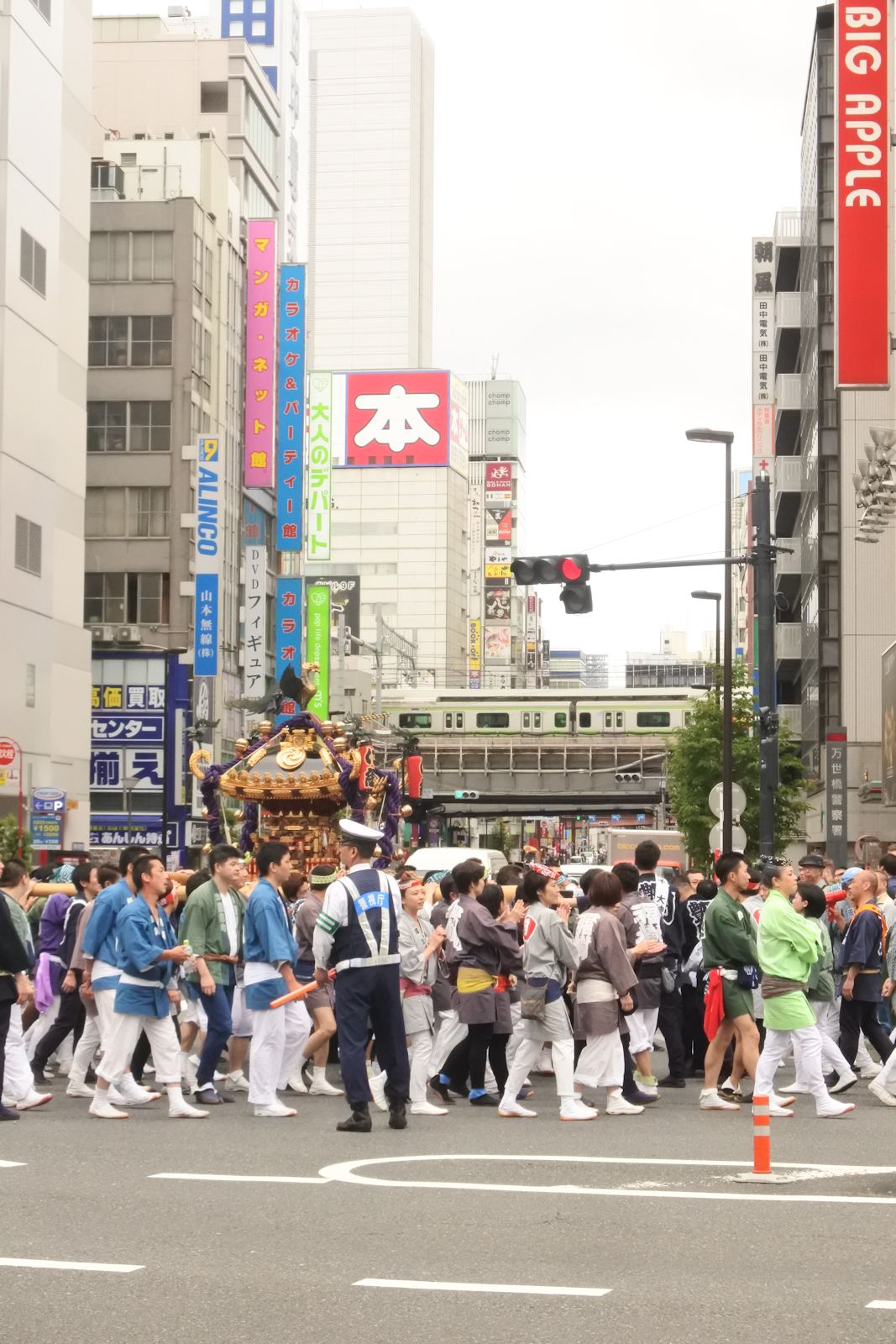
鉄道のある祭りの風景 神田祭
14日、東京・千代田区外神田にある神田明神の神田祭を見に行った。神田明神は、730(天平2)年に当時の豊島郡芝崎村(千代田区大手町・将門塚周辺)に創建。江戸時代初期の1616(元和2)年に現在の外神田に移転(遷座)、社殿は江戸幕府によって建造された。それ以来、江戸総鎮守として、幕府の役人から江戸庶民まで幅広い人々に詣でられるようになった。明治時代には東京の守護神である「准勅祭社」「東京府社」に定められた。また、商売繁盛の神様として年明けには多くの会社経営者が参拝する姿が見られることでも知られている。神田祭は神田明神で2年に1度開催される。毎回5月中頃に実施され、今年2017(平成29)年は5月11日~17日の日程で開催された。14日は神社周辺各地区の神輿が神田・秋葉原・日本橋を練り歩く神輿宮入(みこしみやいり)の日。街中を練り歩く神輿を僕らしい構図で写真が撮れないかと考え、撮り鉄な僕だけに、列車と神輿を共に収めた1枚を撮ってみた。万世橋交差点より、本郷通りから中央通りへと曲がり万世橋方面へと向かう神輿と秋葉原駅に停車中の山手線列車(車両はE231系) From Manseibashi intersection, mikoshi parading from Hongo Street to Chuo Street and a Yamanote Line train (E231 Series) stopping at Akihabara Station淡路町交差点付近から昌平橋方面へと練り歩く神輿と中央線快速列車(車両はE233系)と中央・総武緩行線列車(車両はE231系) From Awajicho intersection, mikoshi and Chuo Line rapid service train (E233 Series) and Chuo-sobu Line local service train (E231 Series)神田祭は僕が東京都民としてぜひとも一度見たかった祭りの1つ。実は前回2015(平成27)年の神田祭を見に行こうと計画を立てていたものの、諸事情により断念。今回初めて祭りの様子を目にした。やはり神輿が街中を練り歩く光景は、日本の祭り特有の荘厳さを感じると同時に、心が清らかになる。この日は日曜日だったこともあり、神輿が練り歩く姿を見ようと多くの人々が神社とその周辺の街に来ていた。参考文献:神田明神オフィシャルサイトOn 14th, I went watching mikoshi portable shrines parade of Kanda Festival being held at Kanda Myojin Shrine in Soto-kanda, Chiyoda-ku, Tokyo.Kanda Myojin Shrine was built in 730, at first located in Otemachi, Chiyoda-ku, at where Masakado-duka is located in the present. In 1616, the early Edo period, the shrine was relocated to Soto-kanda and the new pavilions were built by Tokugawa shogunate. Since then, the shrine had been beloved by many Tokyoites. In addition, on the first business day of every year, many company presidents visit there to pray for prosperity in their business. The festival is being held every two years and this year was between May 11 and 17th. On that day, many local people carried mikoshi and paraded in Kanda, Akihabara, and Nihonbashi area, which was called "mikoshi miyairi".I photographed them with trains on Yamanote Line and Chuo Line (rapid service and Chuo-sobu Line local service).I had been looking forward to watching the festival and planned to do the previous time, but I couldn't go. I saw that mikoshi parade had a solemn characteristic of Japanese festival and it made my mind clear seeing the Shinto Deities in mikoshi nearby. Because of Sunday, many people visited the shrine and the town around there to watch the festival.Some of this article is written based on official website of Kanda Myojin Shrine.
May 14, 2017
コメント(0)
-
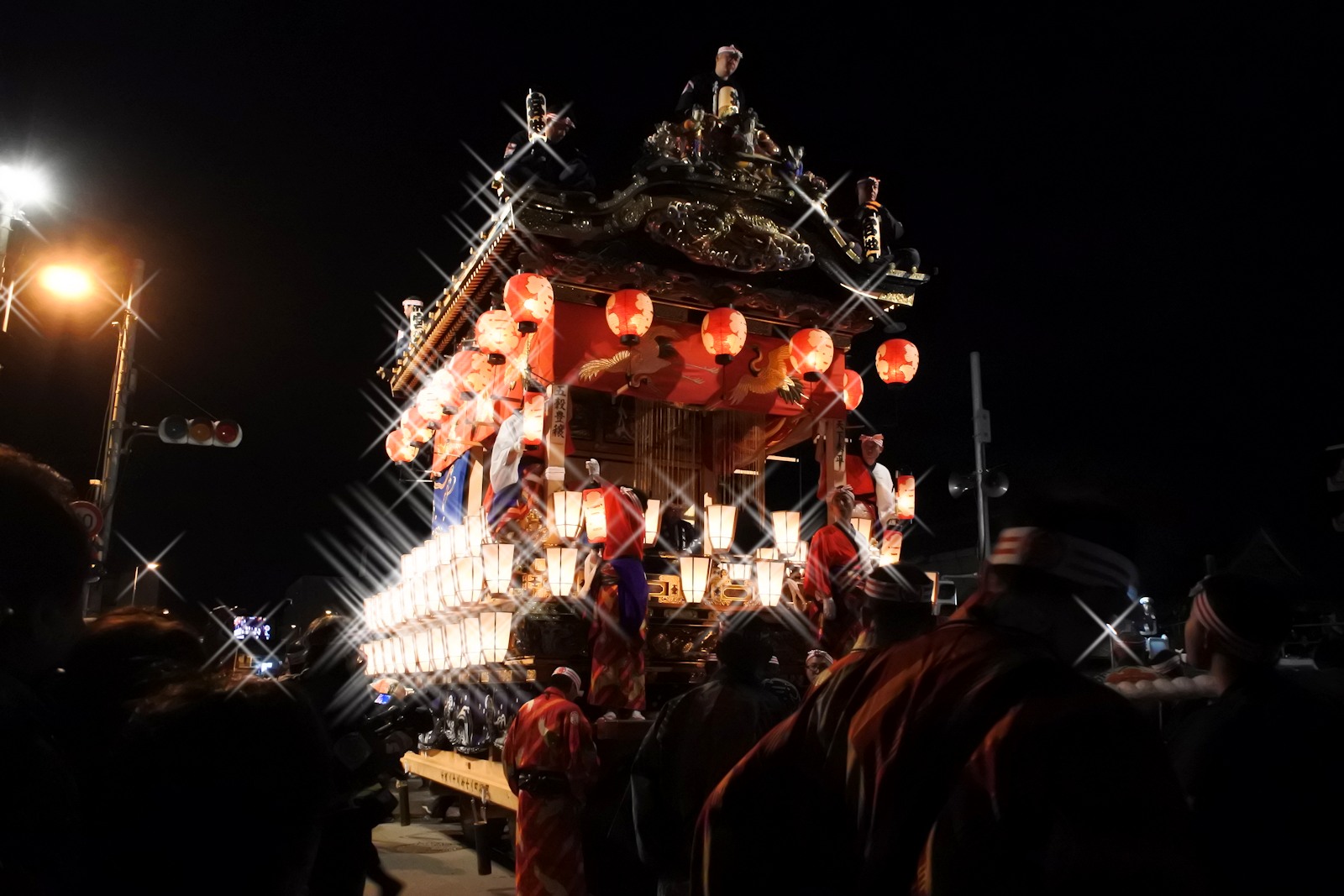
無形文化遺産 秩父夜祭を見る
3日、秩父の冬の風物詩、秩父夜祭を見に行った。秩父夜祭は毎年12月2日・3日に開催される秩父神社の大祭で、6台の屋台・笠鉾が秩父の街を練り歩き、色とりどりの花火が夜空に打ち上げられる。今年2016(平成28)年は秩父夜祭にとって嬉しいニュースがあった。11月30日(日本時間12月1日2:30頃)に、「山・鉾・屋台行事」の1つとして秩父夜祭がUNESCOの世界無形文化遺産に登録されたのである。そのため、それまで以上に今年2016(平成28)年の秩父夜祭は大きな注目を集めた。僕が屋台・笠鉾を見た場所は、聖人通りの秩父鉄道秩父本線の御花畑第2踏切の近く、慈眼寺の交差点(交差点名なし)。山車が来るのを待っている間、背後には秩父本線の列車が通過し、花火が幾度かに分けて数発打ち上げられた。18:30、それまで歩行者天国となっていた屋台・笠鉾の通り道となる聖人通りの車道への人の立ち入りも禁止された。いよいよ秩父夜祭は最大の見せ場を迎えようとしていた。屋台・笠鉾は19:00頃に秩父神社を出発し、国道299号線、埼玉県道73号線、聖人通り、団子坂を経由して秩父市役所付近の秩父公園に作られた御旅所に集結する。そして屋台・笠鉾の練り歩きから遅れること30分、僕の背後の花火の打ち上げも本番を迎えた。そして遂に僕の目に屋台・笠鉾が見えた。On 3rd, I watched Chichibu Yomatsuri Festival, which was held on every December 2nd and 3rd in Chichibu City, Saitama Prefecture. During the festival, Yatai and Kasahoko floats paraded the street and fireworks were set off.This year, a piece of good news for the festival came; as one of Yamahoko Yatai regional festivals all over Japan, the festival was newly inscribed as UNESCO Intangible cultural heritage. So it drew more persons' attention.I had waited for Yatai and Kasahoko coming at a intersection crossing Seijin Street and a unnamed pass where Jigen-ji temple, one of 34 temples in Chichibu and near a crossing on Chichibu Railway Chichibu Main Line. While waiting, I heard Chichibu Main Line train passed and fireworks set off several times.At 6:30 PM, walking on the streets Yatai and Kasahoko would parade started to be prohibited, which means the time for the parade would come. The audience including me gradually got exited.Around 7:00, the parade started and six Yatai and Kasahoko finally reached a special place in front of Chichibu City Hall via Route 299, Prefectural road 73, and Seijin Street. 30 minutes later, the fireworks display started in earnest.It was time that Yatai and Kasahoko came to me.屋台の1つ 写真は宮地地区のもの a float (this image is Miyaji area)秩父の夜空を彩る花火 fireworks慈眼寺の交差点は屋台・笠鉾が聖人通りから団子坂方面へと左折するポイントであるため、「ギリ廻し」と呼ばれる方向転換を間近に見ることができる。ギリ廻しは交差点で屋台・笠鉾が一時停止している間に屋台・笠鉾の床下に人が入ってターンテーブルを取り付け、引っ張っていた人々が縄を回して方向転換する方法のこと。Why I watched Yatai and Kasahoko at the intersection was to see their turning in "giri-mawashi" method.At first, a person in the parade went into the bottom of the yatai and kasahoko to set a turn table while stopping, then those turned them, finally the turn table was removed and the parade kept going.屋台・笠鉾が練り歩く経路の最後の難所である団子坂に差し掛かる手前には秩父本線の御花畑第1踏切があり、山車が架線に引っ掛からないようにするため、踏切部分の架線が山車の通過時刻に合わせて取り外される。当然のことながら、秩父本線の列車もこの時間帯は御花畑駅を挟む秩父駅~影森駅間が運休となる。秩父鉄道の保線作業員さん達が山車の通過を見守る。よく見ると、踏切付近の架線が取り外されていることが解る。On the way Yatai and Kasahoko parading, there was a railway crossing and its overhead wire above the crossing was removed when they paraded around there not to interrupt the parade.Railway maintenance staffs watched the parade for their safety.以前から見てみたかった秩父夜祭をやっと見ることができた。間近に見た迫力ある屋台・笠鉾、夜空を彩る花火、そして切断された架線、すべてが僕の目には輝いて見えた。今回は3日のみ、屋台・笠鉾の練り歩きと花火を中心に見たが、次の機会には2日・3日両日ともじっくりと見てみたい。I had longed for watching the festival. Yatai and Kasahoko, fireworks, and removed overhead wire looked bright. If I would have a chance to go again, I shall see both date and the other events.
Dec 3, 2016
コメント(0)
-
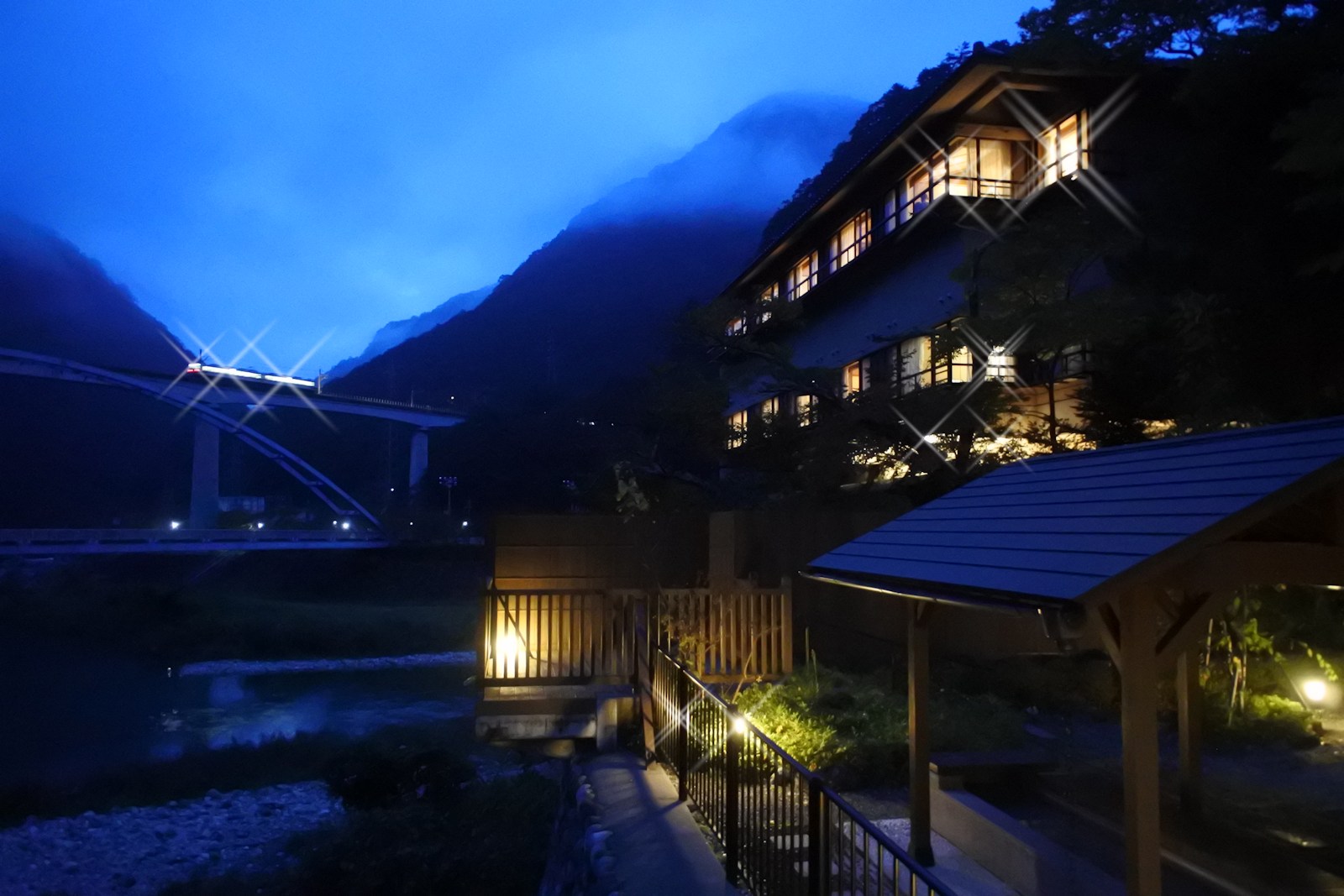
トレインビューの温泉宿 川治湯元温泉 「湯けむりの里 柏屋」
8日・9日、2007(平成19)年以来9年ぶりに栃木県・鬼怒川を旅した。今回お世話になった宿は川治温泉にある「湯けむりの里 柏屋」である。東武特急スペーシアおよびJR・東武直通特急「きぬがわ」の終点、鬼怒川温泉駅から会津田島行き各停列車に乗り換えて約20分、5駅目の野岩鉄道会津鬼怒川線川治湯元駅へ。そこから送迎バスで5分程で「湯けむりの里 柏屋」に到着。「湯けむりの里 柏屋」は鬼怒川沿岸の川治温泉にある温泉宿。鬼怒川とその支流の1つ、男鹿川との合流地点に立地している。客室や露天風呂、そして旅館前の「四季の森」を抜けた先にある鬼怒川に面した展望台と足湯からは、鬼怒川を渡る野岩鉄道会津鬼怒川線の列車を見ることができる、いわゆるトレインビューの宿として鉄道ファンの間で知られている。BS朝日「鉄道・絶景の旅」でも紹介された。宿に到着した僕はまず、玄関入ってすぐ正面のロビーへと案内され、ウェルカムドリンクとして出された緑茶を頂く。「湯けむりの里 柏屋」ロビー Lobby of "Yukemuri no Sato Kashiwaya"お茶を飲み終わって、客室へと案内された。今回の客室は最上階の6階の部屋だった。客室イメージ Image of a guest roomそこはちょうど窓から会津鬼怒川線の列車が走る姿を見ることができる部屋だった。部屋から見えるトレインビューの一例(車両は会津鉄道60200系電車) Image of a view of train部屋から見えるトレインビューの一例(車両は会津鉄道AT-700形気動車とAT-650形気動車) Image of a view of train少し寛いでから、いよいよ温泉の大浴場へ。大浴場からは露天風呂はもちろんのこと、脱衣場・内風呂からも大きな窓越しに会津鬼怒川線の列車を見ることができる。露天風呂から列車の通過を見る。川治湯元駅の時刻表は部屋の利用案内のファイルに綴じ込まれているほか、脱衣場にも掲げられており、入浴前にチェックしておくことをお勧めする。ちなみに大浴場は脱衣場を含めてカメラの持ち込みが禁止されている。水没や湯気による故障からカメラを守るためでもある。しっかりと露天風呂から見える鬼怒川・男鹿川と列車の絶景を目に焼き付けよう。入浴後は一度部屋に戻り、カメラを持って四季の森の先にある展望台へ。夜景撮りにちょうど良い具合に日が沈んだ頃、東武6050系が通過した。旅館と展望台の隣の足湯、鬼怒川を渡る列車の幻想的な1枚を撮影(最上段)。夕食は栃木県産コシヒカリの舞茸ご飯、イワナの塩焼き、お刺身の盛り合わせ、柏屋特製ビーフシチュー等。中でも僕の一番気に入ったものは柏屋特製ビーフシチューである。口に入れた途端にとろけるような柔らかな食感の牛肉が印象的だった。写真が用意できなかったことが残念であるが、それくらい美味しかった。(写真は公式サイト(宿泊プラン→フォトギャラリーへ)もしくは楽天トラベルのページ(写真・動画→食事へ)を参照されたい)翌9日の朝食は、栃木県産コシヒカリのご飯、かんぴょう入り味噌汁、青大豆の豆腐等。朝食の中で印象に残ったものは、かんぴょうの味噌汁と青大豆の豆腐である。味噌汁は、かんぴょうのコリコリとした食感が気に入った。豆腐は、豆腐そのものの独特の香りもそうだが、とろみのかかったたれを付けて食べた時の豆腐とたれの絶妙な味が印象的だった。夕食・朝食とも、栃木県の自然が育てた食材を心ゆくまで楽しめた。川治温泉駅~川治湯元駅間の車窓から見た「湯けむりの里 柏屋」 "Yukemuri no Sato Kashiwaya" seen from window of Aizu-kinugawa Line trainトレインビューがある部屋と温泉、そして地元・栃木県の食材を使った美味しいご飯も大いに気に入った。From October 8th to 9th, I went on a two-day and one-night trip in Kawaji Hot Spring area in Tochigi Prefecture little farther than Kinugawa Hot Spring area. Where I stayed was "Yukemuri no Sato Kashiwaya", which is located where Kinugawa River and Ojika River meets. From the window of the guest rooms and open-air bath, it has a beautiful view of Aizu-kinugawa Line train crossing the river.Changing to a local train on Tobu Kinugawa Line and Yagan Railway Aizu-kinugawa Line at Kinugawa-onsen (Kinugawa Hot Spring) Station, which is the terminal of Tobu limited express "SPACIA" and JR East's limited express "Kinugawa", it took me to Kawaji-yumoto Station with travel time of 20 minutes. Then, complimentary shuttle service for the inn waited in front of the station. It took about 5 minutes to the inn.At first, I was guided to the lobby by a staff and a cup of green tea was prepared.Finishing drinking, I was done to a guest room on 5th/6th floor, where Aizu-kinugawa Line train was clearly seen. In my room, I watched some trains pass from the window and relaxed in a few minutes. Next, I went to hot spring bath. The inn has three types of hot spring bath, inside, outside under the roof, and open air. The view of the river and the train was seen not only from the open-air bath, but also from the big window of inside bath and dressing room. If you would like to watch the train from the bath, I recommend you that you must check the timetable of the train in a folder of how to stay or shown in the dressing room before bathing. Bringing camera to the bath including dressing room is prohibited. After bathing, I went back my room to bring my camera and went to riverside observation deck over "Shiki no Mori" garden spreading in front of the inn.As the sky was getting dark, Tobu 6050 Series running on the bridge was seen. I photographed the inn, foot bath between the two observation decks, river, and carriage visionary (on the top).Coming back my room, dinner time had come. Mixed rice with maitake (Grifola frondosa) fan-shaped and multiple-layered mashroom, sliced raw fishes, salt-seasoned grilled iwana mountain trout, and original beef stew etc. were served. My most favourite one was beef stew, which could be tasty and whose beef well-cooked. The photographs of the dinner was shown on inn's official website or Rakuten Travel website.On the morning of 9th, rice from local farmers, miso soup with kanpyo thin dried calabash fruit, tofu, etc.. Among the breakfast, my most favourite dishes were miso soup and tofu. A characteristic texture of kanpyo in miso soup, flavour of tofu, and taste of tofu in thick sauce were impressive.I really enjoyed the hot springs, view of the train, and the diets made from local ingredients in Tochigi Prefecture.川治温泉 湯けむりの里 柏屋
Oct 9, 2016
コメント(0)
-
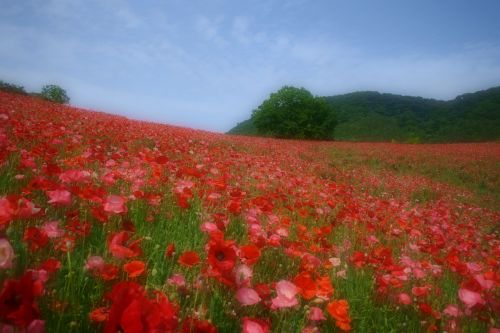
天空のポピーを見に行く
西武秩父駅に初入線したC58形蒸気機関車を撮影した後は、御花畑駅から秩父鉄道秩父本線で皆野駅まで乗車。さらにそこからバスに乗って天空のポピーを見に行った。埼玉県皆野町の高原に1500万本のシャーレーポピー(虞美人草)が咲き誇る。そのシャーレーポピーが青空に向かって伸びていく様子から「天空のポピー」と呼ばれている。毎年5月中旬~6月上旬頃に見ごろを迎える。赤色とピンク色の花がレッドカーペットのように広がり、秩父の山々の緑色と空の青色とのコントラストが綺麗である。秩父地方に咲き誇る花の中では、秩父市の羊山公園のシバザクラ、長瀞町の宝登山山頂のロウバイは見たことがあったが、この天空のポピーは2016(平成28)年に西武鉄道の駅ポスターと車内中吊り広告で初めて知り、これまで見たことがなかった。After photographing Class C58 steam locomotive at Seibu-chichibu Station, I went seeing shirley poppies in Minano Town, via Chichibu Railway Chichibu Main Line.On plateau, 15-million red- or pink-coloured poppies were planted and bloomed in May or June. Those flowers were called "poppies stretching up toward the sky". The blue sky and the green mountains could make a nice contrast with them.Among the flowers and blossoms in Chichibu area, Saitama Prefecture, I've seen moss pinks in Hitsujiyama Park and winter sweet flowers on the top of Mt. Hodo. However, it was first time for me to see the poppies.
May 29, 2016
コメント(0)
-
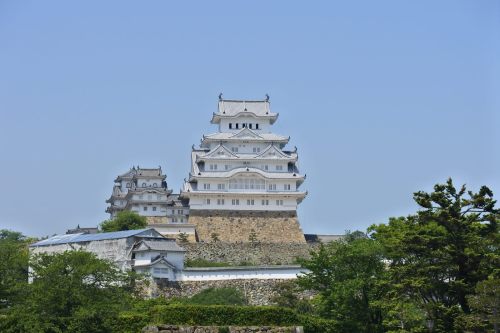
世界文化遺産の城 姫路城へ
姫路駅で新幹線「さくら」を降り、駅前から伸びる大手前通を歩いて姫路城を目指す。姫路城は1346(貞和2)年に赤松貞範築かれた。その白く美しい姿から「白鷺城」として知られる現存する城郭は1609(慶長14)年に初代姫路藩主・池田輝政の手により完成した。1873(明治6)年の全国城郭存廃の処分ならびに兵営地等選定法施行後も生き残り、1931(昭和6)年に国宝に指定され、1993(平成5)年に日本初の世界文化遺産に登録された。2015(平成27)年に平成の大修理を終え、その白さが蘇った。この日は大型連休の間の平日にも関わらず、天守に向かって長蛇の列ができていた。僕が並び始めた時点では、天守に入るだけでも1時間待ちだった。さらにこの日の姫路の気温は25℃を超える暑さだったことから、先の見えない複雑な天守までの道のりに並んでいるだけでも体力を使った。ようやく天守に入ることができたものの、来城客の多さから城内をじっくりと見ている余裕などなく、ほとんど立ち止まらずに進んだ。最上階の6階も人の多さから入れ替え制のような状態で、5階の階段前で6階から先客の皆さんが降りてくるのを列を作って待っていた。最上階まで上がるのにかなりの時間がかかり、その上最上階でもほとんど立ち止まらずに一回りして景色を眺めたものの、何とか写真も撮れた。先ほど歩いてきた大手前通と姫路駅を臨む店主からの景色を1枚撮影。金網が張られていたため、写真は撮りにくいだろうと思ったが、金網が目立たないようにぼかして撮ることができた。姫路駅の新幹線新大阪・東京方面行き列車が到着する11番のりばの待合室の窓からも姫路城の勇姿を拝むことができる。After getting off Shinkansen "Sakura" at Himeji Station, I went visiting Himeji Castle. Himeji Castle had constructed by Sadanori Akamatsu in 1346, and the present structures, known as "Shirasagi Jo (Egret Castle)" due to its whitewashed wall, had reconstructed by Terumasa Ikeda, the first Himeji feudal lord (daimyo), in 1609. After Castle treatment and selecting place of Military Posts Act had come into effect in 1873, Himeji Castle had remained. In 1931, the castle was designated as a National Treasure, and in 1993, be inscribed as a World Caltural Heritage site. In 2015, the large repair finished and revived its beautiful white colour.Though that day was a weekday, many visitors made a long line to the castle tower. As I came there, I had to wait for about an hour on the winding approach just to enter the tower. In addition, the temperature on that day was over 25 (77 Fahrenheit) degree.After going into the tower, I didn't have much time to watch the interior and had to move on, and before going up to the top, I had to wait for persons going down due to the crowdedness. I also had to keep walking around on the top, but I could a photograph of the view of Otemae-dori Street and Himeji Station where I walked from there. Though it was over the wire-netting, it was clear as if there was no net focusing on the station.the castle was seen from the window of booth on the track 11, Shinkansen for Shin-osaka and Tokyo.
May 2, 2016
コメント(0)
-
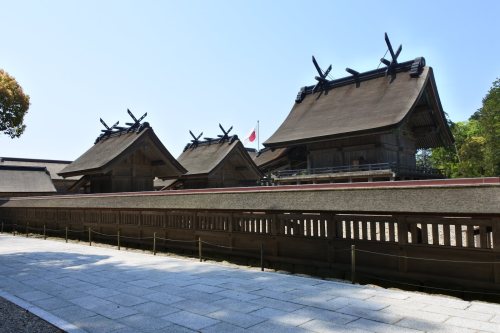
縁結びの神様 出雲大社を参拝
島根県を旅したからにはぜひとも、日本を代表する神社の1つであり、島根県が誇る一大観光地である出雲大社を参拝したい。ということで、初参拝してきた。出雲大社(正式な読みは「いづもおおやしろ」)は大国主大神様を祀る神社。謂れは大国主大神様が太古の昔の人々と共に国土開拓(「国づくり」)に尽力され、「国づくり」を通して、農業・漁業・殖産・医学などの、人々の生活に必要な様々な知恵を授けられ、人々に多くの救いを与えてくださった。その「国づくり」された大地を天照大御神様に奉還(「国譲り」)され、「国づくり」の大業を大層お喜びになった天照大御神様が大国主大神様に、人の目には見えない世界(幽世(かくりよ)=亡くなった人々の霊魂を祀る世界)で人々を見守り、「むすび」の力で人々を幸せへと導くよう、命ぜられた。そして、天照大御神様は大国主大神様のために豪華なお住まいを築かせることを約束し、日本全国から集まった神様達は「天日隅宮(あめのひすみのみや)」と呼ばれる大国主大神様のお住まいとなる宮殿を建造した。この「天日隅宮」が今日の出雲大社である。現代では「縁結びの神様」として知られる出雲大社であるが、前出の「むすび」とは男女の出会いに限らず、様々な人々との、そして人と自然、人とものとの、ありとあらゆる出会いを意味している。そして、毎年旧暦の10月(11月下旬頃)に開かれる、「神在月(かみありづき)」として知られる、日本全国の神様が出雲大社に一堂に会する「神議(かみはかり)」は、神様達が人々の幸せの縁結びを話し合われる会議である。大国主大神様が太古の昔の人々との「国づくり」で苦楽を共にしたことや、天照大御神様の命を受けて、人々の見えないところで「むすび」(=出会い)によって幸せを見守っている物語、そして日本全国の神様達による「神議」が、今なお息づいているあろう。出雲大社の建造物は建て替え(「御造営」と呼ぶ)や修繕(「御修造」と呼ぶ)を繰り返して来たため、大国主大神様を祀るお住まい、「天日隅宮」にあたる本殿(写真右)をはじめとする現存する建造物は、主に江戸時代に御造営されたものとなっている。現在の本殿は1744(延享元)年に御造営されたもので、これまでに4度御修造されている。近年では2013(平成25)年に遷宮(御修造)を行い、大きな話題となったことも記憶に新しい。本殿以外の建造物の御修造も2016(平成28)年3月までに一段落を迎えた。そんな綺麗に御修造されたばかりの出雲大社を、この先の様々な出会いを願って、お参りしてきた。一般的な神社では、二礼・二拍手・一礼でお参りするが、出雲大社では二礼・四拍手・一礼と拍手を4回打つのが習わしである。鳥居をくぐり緑豊かで荘厳な松の参道を歩く。最初は参道の途中にある小さな社殿、祓社(はらえのやしろ)で手を合わせる。参道を通り抜け、続いて拝殿へ。拝殿はこの大きなしめ縄があることでも知られる。そして拝殿のさらに奥にある本殿に向かって八足門からお参りした。本殿は、内側から玉垣と瑞垣と呼ばれる2つの垣根に囲まれているため、近づくことはできないが、外側の瑞垣の周囲を歩くことができ、四方から本殿を遠目に見ることができる。お祀りされている大国主大神は筑紫社の方向を向いているのだという。そのため筑紫社からも本殿に向かってお参りした。参考文献出雲大社参詣案内国宝出雲大社本殿ほか22棟建造物保存修理事業 解説 出雲大社の建造物出雲大社WebサイトIt was first time for me to visit Izumo Taisha Shrine, one of the most famous shrine in Japan and the best sightseeing spot in Shimane Prefecture.Izumo Taisha Shrine (officially named Izumo Oyashiro) enshrines Okuninushi-no-okami, according to The Japanese mythology, who struggled developing land of Japan together with people in the very old time, and gave those his help with their life by agriculture, fishery, industry, and medical studies which the deity learnt through the development. His development was appreciated by and he gave the land to Amaterasu-omikami. Then Amaterasu gave Okuninushi an order that he watched over people beyond those vision to create new encounters, not only man and woman, or findings for those happiness and promised to present a palace to him called "Amenohisumi-no-miya", which was constructed by deities coming from all over Japan. The palace is Izumo Taisha in the present. In addition, the deities hold a discussion called "Kamihakari" on every October, at which they talk to whom they give a luck among people in Japan.The structures in Izumo Taisha has been scrapped, rebuilt, and repaired many times. The present ones are mainly built in Edo Period including the main shrine, which has been repaired four times. The latest was in 2013. The other structures were done by March, 2016.Different from another shrine, visitors crap four times when they make a wish.I first visited "Harae-no-yashiro", small structure at the middle of approach. Keeping going toward the main shrine, I next prayed before worship hall, which was known as a big sacred straw festoon.Then, I came to Hassokumon Gate in front of the main shrine. The main shrine was surrounded by two fences called "Tamagaki" and "Mizugaki". Watching the main shrine, I walked around Mizugaki fence, and made a final vow in front of Chikushisha, toward which it was said that Okuninushi faced.Referencebrochure of Izumo Taisha visitingbrochure 22 structures in Izumo Taisha which are repairedWeb site of Izumo Taisha
Apr 30, 2016
コメント(0)
-
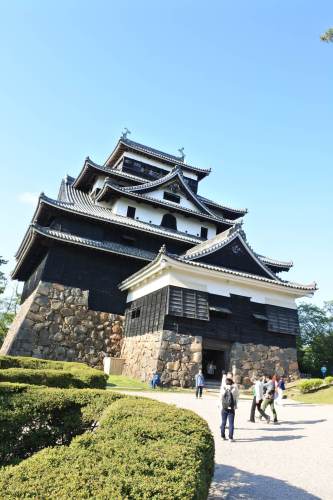
国宝・松江城から宍道湖を一望
松江駅で特急「やくも」を降り、最初に僕が向かった観光地は、松江市のシンボルにして、2015(平成27)年に国宝に指定された松江城。駅から松江城までは、自転車を借りて行った。松江の街を見ながら自転車を漕ぐこと10分ほどで到着した。松江城は1611(慶長16)年、堀尾吉晴・堀尾忠晴らの手により築城された。築城された江戸時代初期より、松江市は松江城の城下町として発展し、松江市の歴史は松江城と共にあったといっても過言ではない。共に国宝に指定されている松本城、姫路城、犬山城、彦根城などの天守と同様の現存12天守の1つである。城内には松江城ゆかりの鎧、武具はもちろんのこと、松江城が築城された江戸時代初期と、昭和30年代、昭和50年代の松江の街のジオラマが展示され、松江の街の変貌ぶりも学習することができる。そして、僕が一番気に入ったものが、天守最上階からの眺め。松江しんじ湖温泉の温泉街と宍道湖、中国山地の山々を臨むことができる南側からの風景が素晴らしい。Where I visited first in Matsue was Matsue Castle, the symbol of the city and designated as a national treasure in 2015.Hiring a bicycle, it took about 10 minutes while seeing the city scenery.Matsue Castle was built in 1611, early in Edo Period, by Yoshiharu Horio and Tadaharu Horio, and more. Since then, Matsue City had been developed as the castle town. In these days, the castle is one of the 12 castles having now-existing tower since Edo period or before that.In the tower, the diorama of Matsue City in Edo Period, 1950s, and 1970s were displayed, as well as the related items such as armours and arms.The most impressive thing for me was the view from the top of the tower. Looking southward, the scene of the city, Lake Shinji, and Chugoku Mountains spread out before.
Apr 29, 2016
コメント(0)
-

運行初日の「Fライナー」で川越へ
3月26日、この日は鉄道各社がダイヤ改正を実施したこの日、僕は注目の新列車の1つ「Fライナー」に乗って川越へ行ってきた。「Fライナー」は横浜高速鉄道みなとみらい線・東急東横線・東京メトロ副都心線・東武東上線・西武池袋線を直通運転する最速達列車の新しい愛称。みなとみらい線・東横線を特急(東横特急)、副都心線を急行、池袋線を快速急行、東上線を急行として運行する。僕は和光市駅から「Fライナー」森林公園行きに乗車した。東京メトロ有楽町線・副都心線からの直通列車が到着する2番線に入線した車両は東急4000系4109F。「Fライナー」を示す黄緑色地に「F」をあしらったマークと共に、「急行 森林公園」の行き先を表示させる姿が、誇らしく見えた。ダイヤ改正前は、朝と夜の東武車による入出庫を兼ねた運用のみで、種別も各停だった東横線・副都心線からの森林公園行き列車だったが、この日からは東急車と東京メトロ車も日常的に、しかも急行列車である「Fライナー」として森林公園駅まで運行される(横高車は8両編成しか存在しないため基本的に「Fライナー」運用には入らない)。和光市駅を発車した列車は、志木駅までの複々線区間は、これまでの東京メトロ有楽町線・副都心線からの列車と同様に中線を走る。中線を急行列車が走ること、そしてダイヤ改正前はすべてのみなとみらい線・東横線・副都心線からの直通列車が停車していた駅を通過することは、やはり新しさを感じた。ふじみ野駅で、先行していた準急列車と接続する。ダイヤ改正前はみなとみらい線・東横線・副都心線からの川越市行き各停列車が東上線池袋駅からの快速列車に抜かれていたが、改正後は逆に「Fライナー」が準急列車をふじみ野駅で追い抜く形になった。列車はいよいよ川越駅に到着。列車は森林公園駅まで運行するが、僕はここで降りる。ここから川越散策を開始。最初に向かった場所は喜多院。その境内ではシダレザクラが美しく咲き誇っていた。喜多院の見所、江戸城から移築された、江戸幕府3代将軍徳川家光公誕生の間と、お地蔵様が何体も並んだ五百羅漢を見学した。お地蔵様は楽器を持っていたり、子供を膝枕させていたり等々、一体一体違った個性豊かな姿勢・行動・表情を見せていた。昼食は「小川菊」のうな重を頂いた。「小川菊」は川越で200年以上続くウナギの名店で、昔も今も高い人気のお店なのか、僕が来た時にはすでに満席で、外にも入店待ちの人が大勢いて、入口前の順番待ちリストを見たところ、60分待ちだった。僕としては、ウナギの味はもちろんだが、店員さんの接客も良かったと思う。僕には鰻重のご飯を多めにするかどうかを聞いてくれ、僕の隣の席にいた外国人観光客には英語で「Can I take picures?(写真を撮りましょうか?)」と声をかけ、スマートフォンのカメラで記念撮影をしてくれた。お店に入ってからだけでなく、順番待ちの時も、まもなく僕の順番が回って来ようという時に、相席の座敷席なら早めに用意ができると最初に聞かれ、僕も了承したものの、数分後にテーブル席が空いたことから、そのテーブル席へと案内してもらうことにした。老舗ならではの長年培われてきたおもてなしを感じ、それが長年愛されている理由のなのだろうと感じた。最後は川越のシンボルとも言うべき時の鐘を見る。時の鐘は昨年2015(平成27)年から耐震補強工事が始まり、櫓の下部が壁に囲われている。そしてこの4月から12月にかけて、櫓全体が壁に囲われて見えなくなってしまう。見えなくなる前に1枚撮っておいた。蔵造りの街並みを見ながら川越駅へと戻り、今回の旅はおしまい。僕が川越の街を歩くのは、大学在学中の2009(平成21)年以来7年ぶりだった。何度か行ってことがある街だが、改めて歩いてみると、時の鐘や蔵造りの街並みなどの「小江戸」と呼ばれる江戸時代の面影を残す街並みの、古くからあるものの趣を感じ取ることができる街だと思えた。On March 26th, the day timetable of many railway lines in Japan changed, I went seeing Kawagoe, Saitama Prefecture by F-liner, one of trains started the service on that day. F-Liner runs between Motomachi-chukagai [Yokohama Chinatown] Station on Yokohama Minatomirai Railway Line and Shinrin-koen [Musashi Kyuryo National Government Park] Station, Saitama Prefecture, on Tobu Tojo Line or Hanno Station, Saitama Prefecture, on Seibu Ikebukuro Line via Tokyu Toyoko Line and Tokyo Metro Fukutoshin Line. F-Liner is regarded as limited express on Yokohama Minatomirai Railway Line and Toyoko Line, as express on Fukutoshin Line and Tojo Line, and as rapid express on Ikebukuro Line.I rode the train from Wakoshi and the carriage was Tokyu 5050-4000 Series 4109F set. Its indicator showed F-Liner logo, white F in a green square and its operation kind and destination "Express for Shinrin-koen [Musashi Kyuryo National Government Park]", which did first time.Before the timetable impoved, trains bound for Shinrin-koen [Musashi Kyuryo National Government Park] from/to those three lines or Tokyo Metro Yurakucho Line only used to operate in the morning and the evening by Tobu carriage and all of them did as local train, also functioned as the ones leaving or entering carriage base near Shinrin-koen [Musashi Kyuryo National Government Park] Station. From that day, Tokyu and Tokyo Metro carriages regularly operate from/to Shinrin-koen [Musashi Kyuryo National Government Park] as F-Liner (Yokohama Minatomirai Railway carriages doesn't regularly operate as F-Liner and go straight through Shinrin-koen [Musashi Kyuryo National Government Park] because of the operator owns only 8-carriage sets).Though the express train runs on outer track F-Liner runs on middle track of quadruple-track section until Shiki, the same as the one before the timetable improvement. I felt it new to pass some stations where the one from/to those three lines stopped and the fast train ran on the middle track.Though the local train from those three lines waited for rapid train from Ikebukuro Station on Tojo Line passing before that day at Fujimino, the train connected to and passed semi express going ahead.The train came to Kawagoe and I got off. Then I started walking around Kawagoe.Where I first visited was Kitain Temple. A drooping cherry blossoms in the temple were fully blooming. I also saw two attractions, room where Iemitsu Tokugawa, the third shogun in Edo preriod, reconstructed from Edo Castle (Imperial Palace in the present) and Gohyaku-rakan jizo stone statues, who individually showed me unique behaviours and expressions.On lunch time, I ate unaju (jubako tiered food box of rice topped with grilled eel) at "Ogagiku", which had been run for over 200 years.As I came there the restaurant was full and I waited for about an hour to enter. I like not only the taste of unaju, but behaviour of waiters were also good. When I ordered, one of the staff asked me to serve the large helping of rice. To foreigners sitting next to me, the other staff did "Can I take pictures?" and took pictures of them eating with their smart phone. Not only in the restaurant, but when I waiting outside she first informed me that sharing a table with other people was faster, but a few minutes later, she changed to show me to a seat not sharing with someone. I felt this likeable service was why this restaurant was loved for a long time.At last, I saw "Toki no Kane (The Bell of Time)", the symbol of Kawagoe. The bell was under antiseismic reinforcement and being covered on this April.I backed to Kawagoe Station while seeing kura storehouses.Travelling first time in these 7 years, I felt Kawagoe, where structures since Edo Period such as Toki no kane (Bell of Time) and kura storehouses is located and which is called "Koedo", had a classical atmosphere.
Mar 26, 2016
コメント(0)
-

秩父の冬を愛でる あしがくぼの氷柱
秩父の冬の名物を見る旅、続いてはあしがくぼの氷柱を見に行く。宝登山を下り、長瀞駅から秩父鉄道秩父本線で御花畑駅へ、さらに西武秩父駅まで歩き、そこから西武西武秩父線で芦ヶ久保駅へ。列車を降り、線路沿いの小道を横瀬駅方面に10分程歩き、線路の下を通り抜けると、一面真っ白の氷が作り出した自然の芸術作品が広がっていた。この日は気温が暖かかったことから、氷柱が溶けて形が悪くなってしまっていないか心配になったが、そんなことはなかった。それどころか暖かさをはね除けてしまうほどの冷気が氷柱の周りに漂い、ここだけ別世界のような感覚がした。氷柱が見える丘の上では、地元横瀬町で取れた茶葉「さやまかおり」を使用した紅茶が無料で振る舞われ、氷柱の冷気で体温下がった身体を温めた。氷柱鑑賞はこれでは終わらない。このあしがくぼの氷柱のお楽しみは夜になってからやってくる。期間中の鑑賞時間は16:00までだが、金・土・日曜日に限り、日没後に、氷柱がカラフルにライトアップされる。ライトアップ時間帯にこの付近を通過する特急レッドアローの一部は、列車の中からもカラフルな氷柱を見易いようにするために徐行運転する。最後に、カラフルに彩られた氷柱とそのすぐ近くを走る西武秩父線の列車を1枚撮影した。Next attraction was Icicles in Ashigakubo.Going down Mt. Hodo, I moved to Ashigakubo Station via Chichibu Railway Chichibu Main Line and Seibu Seibu-chichibu Line. Taking an about 10-minutes walk along a path in parallel with the railway toward Yokoze, I came to the icicle field. The icicles looked like an artwork. Because of the warm weather, I worried about the icicles melt and they looked bad, but it was unnecessary. The field formed a world of its own as it was very cold around the icicles to repel the warm weather.On the top of a hill near the field, I drank a small paper cup of black tea using "Sayama Kaori" leaf cultivated in Yokoze Town to raise my body heat.The attraction of the icicles came in the night; they were illuminated with colourful lights on every Friday, Saturday, and Sunday during the season.During the illumination time, some "Red Arrow" limited express trains slowed down for passengers to be easy to see the icicles over the window.At last, I photographed the icicles and a passing train, whose interior light twinkling toghther with illumination.
Feb 13, 2016
コメント(0)
-
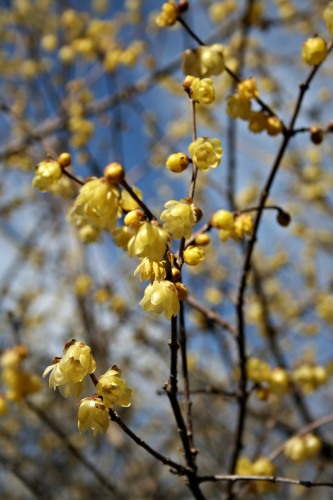
秩父の冬を愛でる 宝登山のロウバイ
2月13日、秩父の冬の名物を見る旅に出掛けた。まずは宝登山のロウバイから。宝登山最寄りの秩父鉄道秩父本線の長瀞駅までは、西武池袋線・西武秩父線の快速急行列車に乗車。長瀞駅の古めかしい駅舎では、秩父鉄道の「鉄道むすめ」桜沢みなのちゃんがお出迎えしてくれた。みなのちゃんの笑顔に少し癒されてから駅舎を出て、駅前から伸びる道を北へ15分程歩いて、宝登山ロープウェイの山麓駅へ。ロープウェイに5分程乗車して山頂駅に到着。駅前では、再びみなのちゃんが出迎えてくれた。ちなみに宝登山のロウバイは、髪の色に似ていることから、みなのちゃんのお気に入りの花という設定にもなっている。ロウバイを見ながら山頂方面へと歩みを進めた。宝登山の山頂周辺のロウバイ園には、この時期約3000本ものロウバイが咲き誇る。小さくてかわいらしい黄色い花がちょうど見頃を迎えていた。そして、山頂に着いた。この日の山頂からの景色は、美しい秩父の山並みもさることながら、眼下の花を咲かせたロウバイの木がこの時期ならではの雰囲気を作り出していた。On 13th, I went seeing the two attractions in winter in Chichibu Area, one of which was winter sweet flowers on the top of Mt. Hodo.Taking a rapid express train on Seibu Ikebukuro Line, Seibu-chichibu Line, and Chichibu Railway Chichibu Main Line, I got off at Nagatoro Station, the closest to the mountain.In the classical station building, the life-size cut-out of Minano Sakurazawa, a "Tetsudou-Musume" character collaborated with Chichibu Railway, stood as if she welcomed people climbing the mountain. It takes about 15 minutes on foot to the station of cable car on the foot of the mountain, and 5 more minutes by cable car between there and the top.In front of the cable car station on the top, Minano-chan, the same as the one at Nagatoro Station, stood, too. Incidentally Minano-chan also loves the flowers because the colour of the flower looks like that of her hair.Watching the flowers, I walk along path to the top. In those days about 3000 yellow small beautiful flowers were blooming.The mountain summit commanded the view of the other mountains in Chichibu Area. The flowers blooming under the view created a seasonal scenery, added to the mountains.
Feb 13, 2016
コメント(0)
-

初めての川瀬祭
20日、秩父の夏の風物詩、川瀬祭を見に行った。去年も見に行こうと思っていたが、天気が優れなかったため断念したことから、今年2015(平成27)年が僕にとって初めての見物となる。川瀬祭の最大の見ものといえば、御輿が荒川に入って穢れを払う「御輿洗い」。これを一度見てみたかったのである。西武秩父駅で列車を降りて、仲見世通りを通り抜け、秩父鉄道の踏切を渡る。いつもは路線バスが多く走る本町通りを封鎖し、そこに出店が立ち並び、大きな山車が練り歩く。山車の上では、氏子である地元の人達が舞を披露していた。出店の軒先ギリギリにまで迫る山車の迫力に圧巻させられた。On 20th, I first go watching Kawase Festival in Chichibu City, Saitama Prefecture. Actually, I had wanted like to go there, but couldn't because of the bad weather. The most attraction of Kawase Festival was "Mikoshi Arai", mikoshi sunk into the Arakawa river water to cleanse the impurities.Getting off a train at Seibu-chichibu Station, I walked to Motomachi Street where floats were parading and many stalls were standing. Some local people performed a dance on the floats. I was surprised at the powerful parade, especially the floats passing close to the front of the stalls.続いて秩父神社にお参りした。神社の境内では、先程街を練り歩いていた山車の姿もあった。ここでも練り歩いていた時と同様に、舞を踊っていた。Next, I visited Chichibu Shrine. In the shrine the floats I met on Motomachi Street stayed and the people kept dancing.参拝した後は、再び本町通りに戻る。昼時になったことから、出店の食べ歩き。途中コンビニや秩父ふるさと館、ほっとすぽっと秩父館で涼みながら、本町通りをぶらりと歩いた。After the shrine visiting, I went back to Motomachi Street and ate something sold at the stalls. While the walking and eating, I dropped into some convenience stores, Chichibu Furusato Kan, and Hot Spot Chichibu Kan to escape the hot weather.僕が頂いたものの一つが、ほっとすぽっと秩父館前で売られていた焼きホタテ。ホタテは岩手県大船渡市越喜来産で、2011(平成23)年に発生した東北地方太平洋沖地震(東日本大震災)以来、秩父市が越喜来を支援しているそうで、館内にポスターが貼られていた。One of what I ate was a grilled scallop with a shell, which was caught in Okirai, Ofunato City, Iwate Prefecture where had been hit the March 11 earthquake and tsunami in 2011, sold in front of Hot Spot Chichibu Kan. Chichibu City had been supporting Okirai since the disaster happened and a poster was shown最大の見せ場まであと1時間となった頃、僕は秩父公園橋(秩父ハープ橋)へと向かい、カメラを構え、御輿の禊を待つ。しかし1時間後の、間もなく禊の時刻となる時に、突然の雨。急遽橋の入口付近のスーパーマーケットで雨宿りをしながら待つことに。10分程度で雨がほとんど止んだと言えるくらいにまで弱まり、再び店の外へ。警備員さんに尋ねてみると、御輿は雨が止むのを待っていたのではなく、山車が川原付近の集合場所に到着するのを待っていたようだ。橋に戻り、再び川に向けてカメラを構えた。そして15:30を過ぎたあたりだろうか、威勢の良い掛け声が聞こえてきた。御輿がすぐそこまで近づいている証拠であった。About one hour before the "Mikoshi Arai", I moved to Chichibu-koen Bridge, also nicknamed Chichibu Harp Bridge, to watch the event. However, the time almost to start the cleansing, it suddenly started to rain. I moved to a supermarket close to the bridge to waited for the rain stopping. Luckily, about 10 minutes later, the rain almost stopped and asked a guard standing outside how the festival went. According to his words, the mikoshi had waited for the floats to come to it, not the rain stopping. Around 3:30 PM, soon after backing to the bridge, I heard a powerful voice, which was the sign for the mikoshi coming to the river.これから「御輿洗い」が始まる合図となる火薬が打ち上げられた。橋の後方から御輿が姿を見せた。The explosive balls, the sign for the beginning the event, were set off. Mikoshi carried and sunk in the river water appeared under the bridge.「御輿洗い」のクライマックスに担ぎ手達が川の水をかけて御輿を清める。これら2つが僕の見たかった、そして撮りたかった秩父の夏を彩るワンシーンである。The climax of "Mikoshi Arai" was that mikoshi carriers threw water at mikoshi. These two were the symbol of Chichibu in summer, and scenes I had wanted to photograph.12月の秩父夜祭に比べて知名度が低いこともあってか、僕も川瀬祭を知ったのはごく最近のことだった。最近、秩父が舞台のアニメ「あの日見た花の名前を僕達はまだ知らない。」の影響や、西武池袋線・西武秩父線の列車の撮影も兼ねて秩父へ行くことが増えたことで、秩父を好きになっていくうちに、川瀬祭を見に行きたいと思っていた。昨年見に行けなかっただけに、見られて良い思い出になった。I knew the festival quite recently because of not so well-known in comparison with Chichibu Night Festival in December. As I gradually love the scenery in Chichibu, influenced by "Anohana ~the flower we saw that day~" anime, in which scenery of Chichibu City was pictured, and visiting while photographing the trains on Seibu Ikebukuro and Seibu-chichibu Lines, I really had been interested in this festival. It was good memory.
Jul 20, 2015
コメント(2)
-
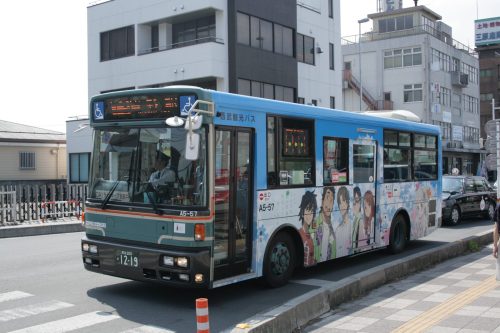
「あの花」ラッピングバスに初遭遇!!
「あの花」ラッピングバスA5-57号車 A5-57 "Anohana ~the flower we saw that day~" livery bus芝桜の丘を下り、西武秩父駅が見えてくると、駅前のバス停を発車したばかりの「あの花」ラッピングの西武バスA5-57号車に初めて遭遇した。同車は昨年2014(平成26)年、レトロ調バスのA7-213号車と共に「あの花」ラッピング車となり、同年11月24日までの間、「ちちぶ巡礼バス」としても活躍した。A7-213号車がほぼ「ちちぶ巡礼バス」専用車だったのに対して、A5-57号車はその他の一般路線でも活躍し、「ちちぶ巡礼バス」の運行終了後も営業運転に就いている。この日は西武秩父駅~皆野駅の路線、T3系統で運行されていた。Going out of the moss phlox garden, I met a Seibu Bus vehicle having a livery of "Anohana ~the flower we saw that day~" anime and tagged as A5-57 by coincidence.As well as a classic-looking one, A7-213, this vehicle had had this livery and had been in service as "Chichibu Loop Line Bus" connecting to some of 34 temples in Chichibu area in 2014. Though A7-213 had been in service almost as the loop line, this vehicle had been as the other lines, and kept being on the regular operation after the loop line ended. On that day, this vehicle was in service as the line T3 from Seibu-chichibu Station to Minano Station on Chichibu Railway Line.「あの花」ラッピングバスA5-57号車 A5-57 "Anohana ~the flower we saw that day~" livery busラッピングに描かれた封筒を持って微笑むめんまちゃん Meiko "Menma" Honma holding an envelope and smiling on the side livery
Apr 29, 2015
コメント(0)
-

10年ぶりに芝桜を見に行く
4月29日、2005(平成17)年以来10年ぶりに羊山公園の「芝桜の丘」へシバザクラを見に行ってきた。羊山公園は埼玉県秩父市、西武西武秩父線の横瀬駅と西武秩父駅とのほぼ中間に位置しており、西武秩父線の羊山トンネルが公園の一部の下を貫通している。秩父の春のシンボルとなっている芝桜の丘のシバザクラは、毎年4月中旬~5月上旬に見頃を迎え、見頃が大型連休中と重なることもあって、同期間中は多くの人で賑わう。横瀬駅から芝桜の丘へのルートは数種類あるが、僕は線路沿いの道を歩いていくことにした。線路沿いに15分程歩いて公園へたどり着くと、線路脇の駐車場には多くの観光バスの姿が見え、臨時の西武秩父駅からの無料送迎バスも発着していた。線路下を通り抜けると、多くの人達が芝桜の丘を目指して歩いていた。幸い途中で止まることもなく、道案内も出ていたことから、僕もスムーズに芝桜の丘までたどり着くことができた。芝桜の丘は見頃の期間中のみ、シバザクラの保護と育成への協力金として300円の入園料を支払う。入園券を買って、いよいよシバザクラがお出迎え。10年ぶりの芝桜の丘に、僕は思わずうっとりとした。そして一面に咲き誇る濃淡ピンクや薄紫色、白色などのかわいらしい花が、背景の公園内の木々や秩父の山々の緑とよいコントラストとなるこの風景は、秩父の春を綺麗に彩るものだということに、改めて気が付いた。On April 29th, I went seeing moss phlox blossoms in Hitsujiyama Park, Chichibu City, Saitama Prefecture, which was located in about the middle of Yokoze Station and Seibu-chichibu Station on Seibu Seibu-chichibu Line and under some part of which the railway ran through.The flower season comes between in the middle of April and the first 10 days of May. There were several routes from Yokoze to the park, but I chose the one along the railway. Taking a 20-minute walk, I saw a large amount of tourists and buses, some of which shuttled passengers from Seibu-chichibu, and the other were chartered by the tourist agencies, at a parking.Crossing under the railway and following the tourists and the guide, I approached the moss phlox garden, where I haven't been for 10 years.To enter the garden in the flower season it cost 300 yen to cooperate the protection of the garden and flower.I was moved by and remembered that the scenery the flowers making a good contrast with the green of the trees and mountains was the symbol of Chichibu in spring. このかわいらしいシバザクラの花が、そしてこの花と秩父の山々が成す風景が、いつまでも続くことを祈りたい。I wish the flowers and the scenery lasts for a long time.
Apr 29, 2015
コメント(2)
-

「ちちぶ巡礼バス」で「あの花」の風景を巡る
24日、今話題沸騰の「ちちぶ巡礼バス」に乗って秩父の街を旅してきた。西武秩父駅のバスロータリーで発車を待つちちぶ巡礼バス レトロ調バスのA7-213号車 the vehicle numbered A7-213 for "Chichibu Loop Line Bus" at the bus stop in front of Seibu-chichibu Station against Mt. Butko西武秩父駅のバスロータリーにやってきたのは、ボンネットスタイルのレトロな雰囲気と、「あの花」の登場人物達で彩られたかわいらしいバス。ドアが開いた直後から、車外スピーカーから聞こえてきたのは、「あの花」のめんまちゃんのかわいらしい声。「このバスは、札所十七番入口、秩父橋、音楽寺経由、西武秩父駅行き、『ちちぶ巡礼バス』です」。発車する前から癒されてしまった。僕は一番前の席に座ることができた。車内には、「あの花」のイラストとバスが巡る作中で描かれた風景の写真のステッカーが天井に貼られていた。そして、発車時刻を迎える。「大変お待たせいたしました。『ちちぶ巡礼バス』にご乗車いただき、ありがとうございます。」めんまちゃんのかわいらしい声が、今度は車内に響き渡る。バスの車内はまさに「あの花」ムード全開になっていた。バスは秩父鉄道の踏切を渡り、明治・大正時代に建設された趣のある建物と、現代的な建物とが混在している埼玉県道73号線~国道299号線へ。最初に僕が降りたのは秩父駅バス停。秩父鉄道秩父駅駅ビル内の「秩父地場産センター」を覗いた。ここでは秩父市の特産品はもちろんのこと、「あの花」グッズも購入することができる。ここで僕は「あの花蒸しパン」を1個購入。作中でめんまちゃんが作っていた蒸しパンをイメージした、レーズン入りの蒸しパンである。次に先ほどバスが来た道を戻る形で、「ほっとすぽっと秩父館」へ向かう。ほっとすぽっと秩父館 前の街灯も趣のある雰囲気 Hot Spot Chichibu-kan and classical-looking street rampここは明治時代に建てられた旅館の建物を改装した観光情報発信施設。囲炉裏がある部屋を休憩スペースとして開放している。ここでも「あの花」グッズを買うことができる。「ちちぶ巡礼バス」は1時間に1本の運行。次のバスまでかなりの時間があったため、次の目的地・定林寺まで歩いてみることにした。定林寺 Jorin-ji temple定林寺は、観音堂と寺務所、鐘が集約された小ぢんまりとした境内の寺。秩父札所十七番に指定されているこの寺も「あの花」の作中に何度か登場したことがある、ファンには人気のスポットとなっている。定林寺は戦国時代の1593(文禄2)年に創建された。秩父市の史跡にも指定されているほか、梵鐘が埼玉県指定の文化財となっている。札所十七番入口バス停にて 武甲山を背景に走るちちぶ巡礼バス The bus at Fudasho 17 bus stop (nearest Jorin-ji temple) against Mt. Buko札所十七番入口バス停から「ちちぶ巡礼バス」の旅を再開。次の目的地はもっとも有名な「あの花」スポットと言ってよいだろう秩父橋である。秩父橋バス停に停まるちちぶ巡礼バス The bus stopping at Chichibu Bridge stop作中に何度も登場し「あの花」ファンにはおなじみの旧秩父橋 View of 2nd- and 3rd-generation Chichibu Bridge旧(2代目)秩父橋は1931(昭和6)年に建設された。埼玉県内では古くからあるコンクリートアーチ橋で、1999(平成11)年に埼玉県の有形文化財に指定された。逆Y字型の主塔が美しい、写真奥の3代目の橋が完成してからは、遊歩道として整備され、現在に至っている。ありきたりな構図になってしまったが、旧秩父橋から3代目秩父橋を望む「あの花」のオープニングを意識したアングルで1枚。ここは吉高由里子さん出演の西武鉄道のTVCMにも登場した橋でもある。荒川の川原の緑と、川の向こう側の秩父太平洋セメントの工場(秩父鉄道の大野原~和銅黒谷間の車窓からも見える)を臨む構図でも1枚 photographing the scene of Arakawa River and Chichibu Taiheiyo Cement plant from 2nd Chichibu Bridge今回はここまで。次回以降、今回見ることができなかった「あの花」の風景をカメラに収めたい。On 24th, I went travelling in Chichibu, Saitama Prefecture, to watch and photograph scenery which is pictured in "Anohana ~the flower we saw that day~" with "Chichibu Loop Line Bus".The vehicle for the line is classical-looking with the engine bonnet and decorated with "Anohana" characters.When its door opened, Meiko "Menma" Honma (voiced by Ai Kayano)'s cute voice from the outside speaker. I was attracted by her voice before the bus' departure.I could sit on the front seat. Its interior was also decorated by "Anohana" characters and the photographs of the spot along the bus route.As the bus departs on time, Menma-chan's voice played the inside. The decorations and the annoucement created the atmosphere of "Anohana" world.Crossing Chichibu Railway, the bus went into Saitama Prefectural Route 73 and Japan National Route 299, along which both classical buildings built in 19th and 20th centuries and modern buildings stands.Where I first got off was Chichibu Station, then I dropped into "Chichibu Local Industry Centre", where you can buy not only local productions in Chichibu, but also some "Anohana" goods. There I got a steamed bun with plums, which was based on the one Menma-chan made in the story.Returning the route the bus ran, I next visited "Hot Spot Chichibu-kan", to which an old inn was refurbished and where you can get some information.It has a room with irori fireplace opened to the public and you can also get "Anohana" goods.The classical-looking street ramps blend in with the old building.Leaving there, I walked to Jorin-ji temple because I had much time to when next bus would come.Jorin-ji, number 17 of 34 Chichibu temples, was a compact temple; there were only main hall, an office, and a temple bell only, and was established in 1593. It is also designated as a historical site in the city and its bell as a Prefectural Cultural Property.From Fudasho 17 bus stop I restarted the bus travel again to go to the most famous place among "Anohana" fans, Chichibu Bridge.2nd-generation Chichibu Bridge had been constructed in 1931 as one of the early concrete arch bridge in Saitama Prefecture. As a highway bridge, it was replaced by 3rd-generation bridge constructed in 1985 with inverted Y-shaped suspension bridge tower. The 2nd bridge had been functioned as a pedestrian bridge since then.Though it was a ordinary layout, I photographed the two bridges like when it was pictured in "Anohana" anime. It had also appeared on a Seibu Railway's commercial featuring Yuriko Yoshitaka.This time had been finished. Next time, I really would like to see the places where I couldn't visit this time to get more photographs.
May 24, 2014
コメント(0)
-
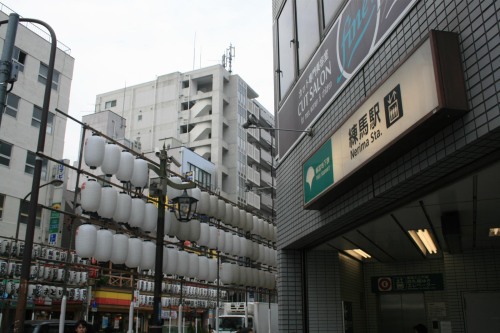
練馬・大鳥神社の酉の市を見てきた。
3日、練馬駅近くの神社、大鳥神社の「大酉祭」(一の酉)を見に行ってきた。駅を出るとすぐに祭囃子が聞こえ、たくさんの提灯の列が出迎えてくれ、お祭りムードを作り出していた。On 3rd I went seeing Otori Festival at Otori Shrine near Nerima Station, Nerima-ku, Tokyo.As I got out of the station, I heard festival music and many paper lanterns, which made an atmosphere of the festival.駅南側から目白通りの間に広がる商店街の一角に大鳥神社があり、境内では酉の市の象徴「飾り熊手」が売られていた。The shrine stands among in the shopping street spreading from in front of the railway station and Mejiro Street, where the symbol of the festival and a decoration for new year, decorative bamboo rake, was sold.古くから正月飾りとして親しまれてきた「飾り熊手」。起源は、各地の神社で収穫祭の日に露店で「熊手」が売られていたこと。落ち葉や干し草をかき集める道具として使われていたことから、江戸時代頃より、お金や幸福をかき集めることを連想させ、縁起物として「飾り熊手」が神社の酉の市で売られるようになったようだ。The origin of the decorative rake is the rakes or pitchforks being sold at harvest festival. They were used for collecting fallen leaves or hay, which was associated with gathering money or fortune. Due to this image the decorative rakes started to be sold as a lucky charm at the shrine market on November.僕が来た時は、出店の多くが準備中だった。しばらく商店街のお店で時間をつぶした。お昼前の11:30頃から、出店の多くが営業を始めた。ここから僕の楽しみである出店食べ歩きをスタート。商店街に出店が並んでいたことからか、出店とともに商店街のお店のいくつかも店頭販売をしており、中華料理店や古着屋などがそれをしていた。When I came there many stalls weren't ready to run. Then I spent time while seeing some stores in the shopping street.Around 11:30 AM, the stalls started their business. I started to eat foods selling at the stalls while walking. On the street some stores, such as Chinese restaurants and a secondhand cloth shop, also started the over-the-counter sale or the sale on the street.中華料理店で店頭販売されていたチャーハンと、出店のお好み焼きとクレープの3品。The foods I ate were fried rice at a Chinese restaurant, a Okonomiyaki pancake and a crape at stalls.チャーハンは以前食べたことがあるお店のもので、エビやグリーンピース、輪切りのネギが入っていた。ご飯はパラパラで、エビの食感もよく、僕好みの味だった。The fried rice, which was sold at a restaurant I had been to, was cooked with shrimps, green peas, and round-sliced leek. I felt the rice was cooked well and the texture of shrimps were also good. お好み焼きは、「月島流」と名づけられたもんじゃの生地を使用して焼かれたもの。生地と具材を混ぜた物を焼くのではなく、薄く広げられたもんじゃ生地の上に千切りキャベツなどの具を載せ、最後に目玉焼きにした玉子を載せて作る、広島のお好み焼きに似た作り方だった。味はまあまあといったところだろうか。Okonomiyaki pancake, , made from thin wet wheat dough for Monja, local food in Tsukishima, Tokyo, shredded cabbage and some vegetables and sliced meat, and egg sunny side up, on the dough in order, not mixed each other like the one in Hiroshima Prefecture. It was also delicious, but not so much.最後のデザートのクレープはブルーベリージャム味を選んだ。僕が好きなフルーツがブルーベリーだからだ。一度クレープの食べ歩きをやってみたかったため、今回やっとやることができてよかった。Finally, I ordered a crape with blueberry jam. I would have liked to try to eat a crape while walking. I felt good that eating some foods or snacks while walking at a shrine festival was really good.
Nov 3, 2013
コメント(0)
-

能登の牡蠣を頂く
西岸駅が位置している石川県七尾市中島地区は、カキが名産品。西岸駅の隣の能登中島駅周辺を中心にカキが食べられる食事処が多い。西岸駅の周辺でカキを食べられるお店がないかと探して見つけたのが、「宮本水産」さんだ。Nakajima in Nanao City, Ishikawa Prefecture, where Nishigishi Station is placed, is famous for oysters. Mainly around Noto-nakajima Station, the neighbour one of Nishigishi, many restaurants serving oysters stands. I chose Miyamoto Fishery nearby Nishigishi where I found on the internet before travelling.まず最初に僕が頂いたのは、生の大きな岩ガキ。大きな貝殻に載ったこれまた大きな実。カキは一般的に冬が旬だが、岩ガキは夏が旬。柔らかくどこかコリコリとした歯ごたえの独特の食感が印象的で、貝殻に滴り落ちた液体はまさに「海のミルク」と呼ぶにふさわしいクリーミーなものだった。What I ordered first was a raw oyster. Though oysters generally be eaten in winter, but the season of this one, called "Iwa-gaki" sticking to rocks in the ocean, is summer. The soft but crunchy texture was impressive and the liquid dropped from the oyster on the shell was really creamy.続いて僕が一番好きなカキ料理のカキフライを食す。プリプリのカキを揚げたアツアツのフライは、レモンをかけても、タルタルソースをかけても、美味しかった。Next I ate deep-fried oyster, which is my most favourite food using oysters. Fresh oysters covered coating was delicious with both lemon and tartare sauce.
Aug 10, 2013
コメント(0)
-

金沢街めぐり 鼓門・もてなしドーム
金沢駅へ戻ってきた。最後に金沢駅のシンボル「鼓門」をカメラに収めた。左右の柱が楽器の鼓のような形となっていることからこの名が付けられた。鼓門の奥には、ガラスを敷き詰めた「もてなしドーム」がある。このガラスのドームは雨傘をイメージし、雨の日でも利用客が濡れないようにとの「おもてなし」の心を表している。The last of my sightseeing in Kanazawa, I photographed Tsuzumi gate of Kanazawa Station, which is named after its two big pillows like like tsuzumi hand drum.Entering the gate vault glass ceiling called "Motenashi Dome", which was created for the people not to be wet when it raining.
Aug 9, 2013
コメント(0)
-

金沢街めぐり 長町武家屋敷跡
近江町市場で腹ごしらえをして、北陸鉄道バスに乗り香林坊バス停へ。そこからひがし茶屋街と共に江戸時代の面影を残す長町武家屋敷地区へ。一般の見学が可能な野村家は、前田家に仕えた野村伝兵衛信貞の邸宅であり、廃藩まで11代にわたって加賀藩の御馬廻組(大名の護衛職)組長や各奉行職を歴任した。ミシュランガイドで2つ星を獲得し、イギリスのジャーナル・オブ・ジャパニーズ・ガーデニング誌でも日本庭園ランキング3位にランクインするなど、海外からも高評価を得ている。After the lunch at Omicho Market I visited Nagamachi Samurai Residential District, by Hokuriku Railway Bus and on foot from Korinbo bus stop.Nomura-ke, which could be appreciated by Michelin Guide, with 2 stars, and The Journal of Japanese Gardening, with third rank, is the only one residence which tourists can see. Since Toshiie Maeda had become Kaga domain lord 11 Nomuras had served ad the leader of guard of lord and several local ministers. 邸宅本体だけでなく、庭も風情あるものであり癒される。庭の美しい緑はもちろんのこと、池を泳ぐコイや縁側下の小さな滝からの飛沫が涼しさを演出している。Not only the building itself, the trees, a pound, in which some carps swims, and a small waterfall in the garden made me cool.
Aug 9, 2013
コメント(0)
-
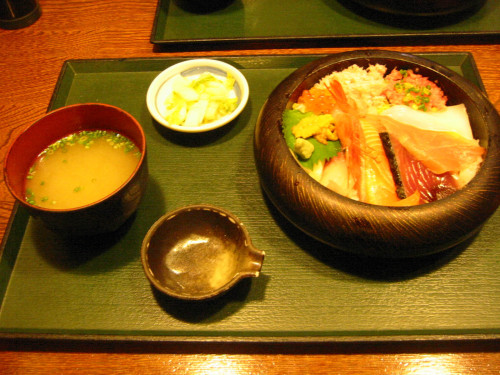
近江町市場で昼食
2日目の昼食は近江町市場の近江町食堂の海鮮丼。マグロ・カツオ・サケなどの切り身とエビ・イクラ・ウニなどの、日本人が大好きな魚介類が器いっぱいに盛られている。僕も魚介類大好きな日本人の一人であり、近江町市場は新鮮な魚が出揃う場所だということで、金沢に行ったら、近江町市場の海鮮丼を食べようと決めていた。My lunch on the 2nd day was a bowl of rice topped with fish fillets at a restaurant in Omicho Market.It consists of many kinds of fish Japanese people love, such as tuna, bonito, shrimp, salmon, salmon row, and urchine, etc.Because Omicho Market is famous for fresh fish and seafoods and I love to eat fish and seafoods, I had decided to have this diet when visiting Kanazawa.
Aug 9, 2013
コメント(0)
-
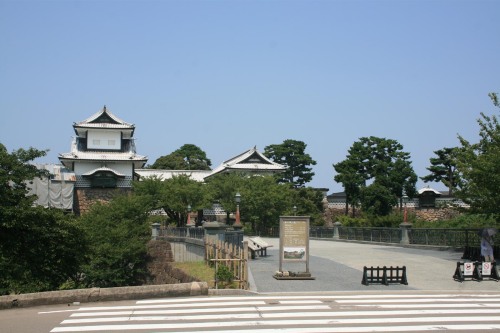
金沢街めぐり 金沢城公園
兼六園と道路を挟んで向かいあう金沢城公園へ。1583(天正11)年、前田利家公が入城して以来、加賀百万石のシンボルとなっている金沢城は、14代に渡る前田家による支配が続いた。しかしその一方で、実は幾度も焼失を経験している。明治維新による廃藩後は、旧陸軍の活動拠点となり、戦後は金沢大学のキャンパスが置かれた。金沢大学は「お城の中のキャンパス」として話題となり、全国から入学希望者が殺到した。1997(平成9)年に金沢大学が移転し、この土地を石川県が購入。城の復元工事が今なお進行中である。Where I visited next was Kanazawa Castle, across the street from Kenrokuen.Since Toshiie Maeda becoming the domain head of Kaga in 1583, 11th year of Tensho Period, the castle had been the symbol of Kaga, and the administration by 14 Maeda heads lasted the end of the Edo Era. However, actually, it had been lost by fire several times in the Edo Era. After the Meiji Restoration the land of the castle changed to an Army base, and the campus of Kanazawa University was built after World War Two. The university was called "campus in the castle" and became many applicants' first choice.In 1997 the university moved to another place and Ishikawa Prefecture purchased the land to restore the castle. The castle still be under restoration.3枚目の写真は、2010(平成22)年に復元された河北門の内部。能登ヒバが建材として使用されており、木造建築の温かみを感じられる。ここの床には石落としの仕掛けが仕組まれており、外敵からの侵攻を防いだのだという。The third photo is the inside of Kahoku Gate which had been restored in 2010. Noto Hiba thujopsis is used as fabric, which makes the warm atmosphere. Its floor has some rectangle holes to fall the stone not to be invaded in the old time.
Aug 9, 2013
コメント(0)
-
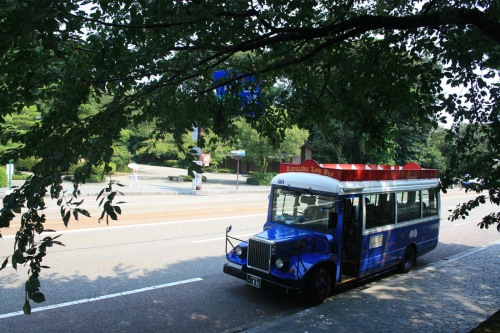
金沢街めぐり 兼六園
続いては、金沢を訪れたからには必ず行きたい兼六園へ。金沢城の外郭庭園として、歴代金沢藩主の手により造成されてきた回遊式庭園。1874(明治7)年より一般に開放され、1985(昭和60)年に国の特別名勝に指定された。茨城県水戸の偕楽園、岡山県岡山の後楽園と共に、「日本三名園」の一つに数えられる。Following Higashi Chaya District, I visited to Kenrokuen Garden, the best known sightseeing spot, and belonging to Kanazawa Castle in the Edo Period, had been created by the domain heads. In 1874 it had been opened publicly and in 1985 chosen to a special place of scenic beauty. It was called one of the 3 best known Japanese garden as well as Kairakuen in Ibaraki Prefecture, and Korakuen in Okayama Prefecture. 兼六園下バス停に停車中の「城下まち金沢周遊」バス"Kanazawa Loop Bus" stopping at Kenrokuen-shita bus stop兼六園のシンボル 霞が池Kasumigaike pond, the symbol of Kenrokuenこの時霞が池では、池の底に溜まった汚れを掃除している最中だった。この日は池底の掃除が終わり、抜き取っていた水を戻す作業が前日から行われていて、カメやコイが池に戻されていた。地元石川県のテレビ局の記者が多くカメラを構えており、僕もカメやコイが戻される瞬間を目に焼き付けた。この日よりも前に来てしまっていたら、水がない霞が池という殺風景な池しか見ることができなかったため、ちょうど良い日を選んだと言えた。On that day the cleaning of Kasumigaike's bottom finished and the water and some turtles and carps came back to the pond. Some cameramans from local TV stations came there to report the release. I also watch the turtles and carps come back to the pond.If I had been there before that day, I couldn't see only a bleak scene without the pond water.
Aug 9, 2013
コメント(0)
-
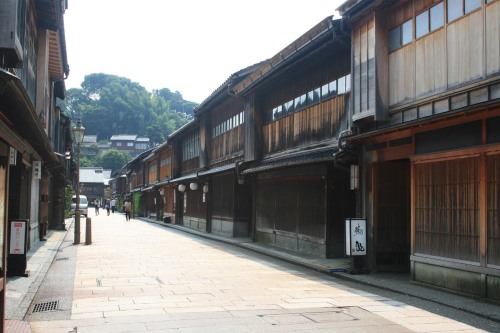
金沢街めぐり ひがし茶屋街
2日目の8月9日、初めての金沢ということで、この日は一日金沢観光名所めぐり。金沢駅前から「城下まち金沢周遊」バスに乗って最初に向かったのは、ひがし茶屋街。The second day, August 9th, due to my first visit to Kanazawa, I went seeing some famous spots. Getting on a "Kanazawa Loop Bus" from Kanazawa Station, I first went to Higashi-chaya District.金沢が「北陸の小京都」と呼ばれる所以になっている、江戸時代の城下町の面影を残す地区の一つ。兼六園と共に訪れる観光客が多い場所だが、この日はお盆休み前だったためか、人がまばらだった。This area remains the atmosphere of a town around a big castle in the Edo Period, which is the reason why Kanazawa is called "small Kyoto in Hokuriku". Though it is where many tourist visit there as well as Kenrokuen, there were a few tourist because of before the Obon holidays.僕がひがし茶屋街で街並みと共に気に入ったものが、「黄金の蔵」。金箔を使ったお土産品を売っている「箔座」というお店の中庭にあり、外壁は金とプラチナの合金箔、内装の壁は金箔を敷き詰めたものとなっている。黄金の蔵の金箔らしい輝きを表現できる写真を撮るのは意外に大変だった。My most favourite as well as the town atmosphere was the "Gold wearhouse-like tearoom", standing in the courtyard of a souvenir shop "Hakuza", which treats the goods using gold foil, one of the famous product in Kanazawa. The outside wall is covered by the foil made from alloy of gold and platinum, and interior is by gold foil.Photographing the building featuring its shining gold wall was little difficult for me.
Aug 9, 2013
コメント(0)
-
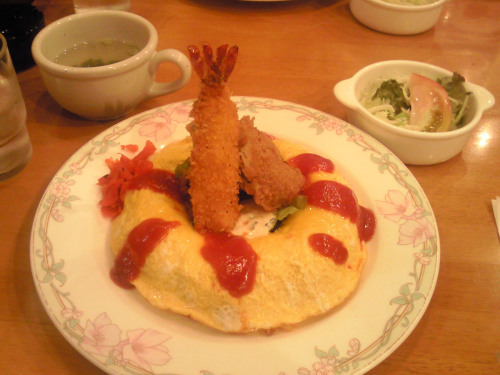
金沢名物を食べる
8日の夕食は、金沢駅高架下の金沢百番街の中にある「カフェレストランGinrei」で、金沢の名物料理の1つ、「金沢ハントンライス」を選んだ。以前読んだガイドブックに写真が載っていて、美味しそうに見えたため、食べたくなった。金沢ハントンライスは、オムライスの上に白身魚とエビのフライを載せたもの。オムライスはもちろん美味しかったが、2種類のフライのサクサク感もたまらなかった。I ate one of the famous foods in Kanazawa "Hanton rice", which I had found on a tourist guide book, at a restaurant "Ginrei" in "Kanazawa Hyakubangai" under the JR railway.It consists of ketchup-fravoured rice covered with thin cooked egg, and topped with fried whitefish and prawn/shrimp. The 2 fries, as well as the rice, tasted good.
Aug 8, 2013
コメント(0)
-
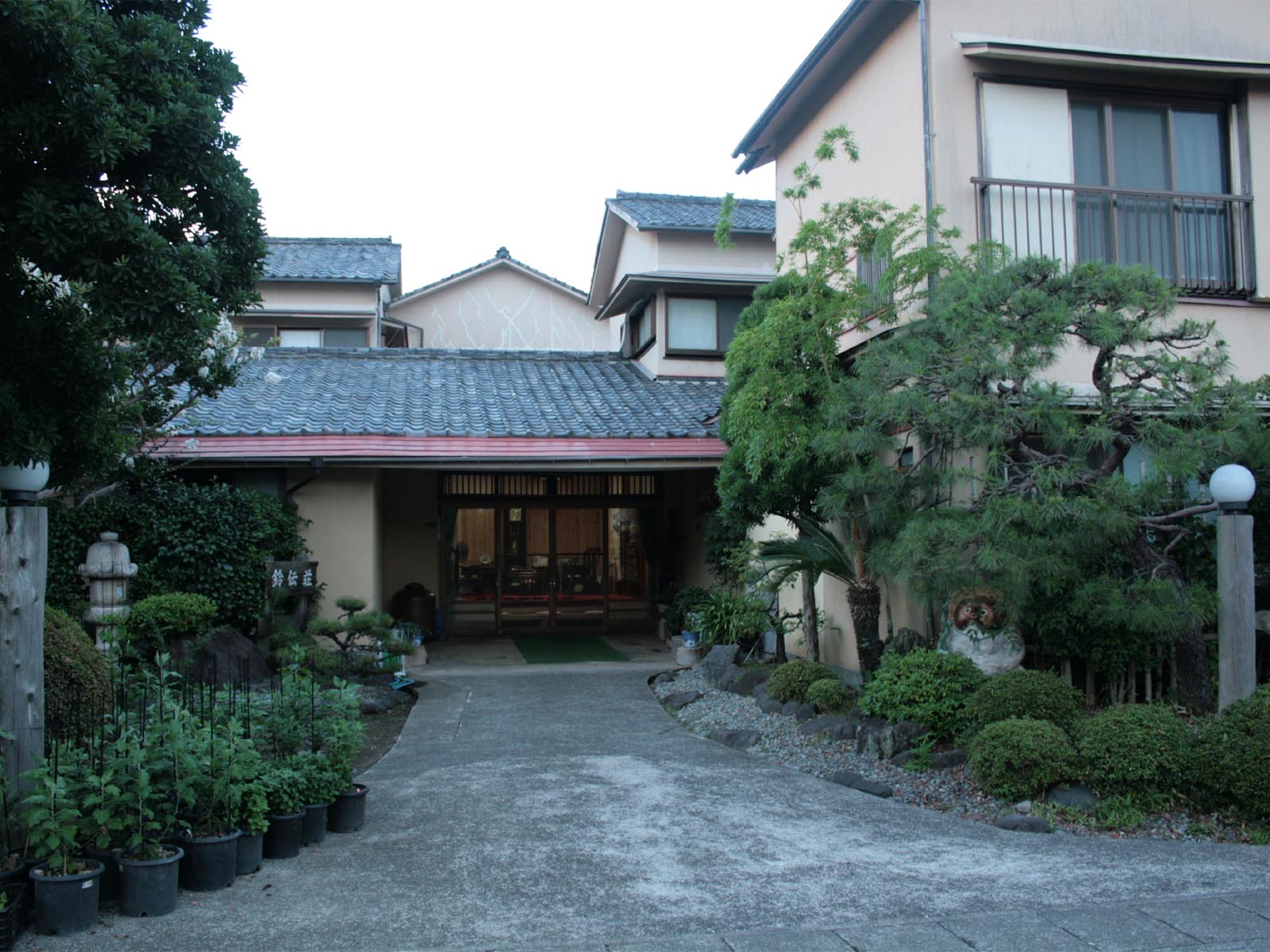
南伊東の隠れた温泉宿
今回の宿は、南伊東駅から歩いて4分ほどのところに位置する小さな温泉宿、「伊東温泉 鈴伝荘」。南伊東駅から線路沿いの道を伊東方向に歩いていくと、「鈴伝荘」の看板が見え、そこを右に曲がって少し歩いたところにある。ここは本来は京王電鉄の保養所であるが、一般の旅行客も泊まることができる。客室は10畳ほどの和室で、一人旅にはちょうど良いサイズの部屋だった。客室からは伊豆急行線の電車の音も聞こえる。温泉は源泉かけ流しで、1階に内風呂、2階に露天風呂がある。内風呂、露天風呂とも男湯・女湯の区別がなく、入浴する前に脱衣所の入口にある札を「入浴中」にひっくり返す。女性の方が入る場合は「入浴中」の札の下に「ご婦人」の札を下げるようだ。2階の露天風呂は風呂と脱衣所のみがあり、鏡やシャンプーはない。そのため、入浴の順番としては最初に1回の内風呂に入って頭と体を洗い、その後で2階の露天風呂に入るのが、オススメである。朝食は、ご飯、味噌汁、納豆、生卵、鯵のひらき、いかそうめん、春雨サラダ、きゅうり、かまぼこ、焼き海苔、ヨーグルトだった。The inn where I stayed at was "Suzuden-so" in Ito City, which four-minute walk brought from Minami-ito Station.Going straight toward Ito Station along the railway of Izu Kyuko Line, I saw a small board of the inn and turn right there. Then about a minute walk from the corner, the inn stands on my left. At first, the inn started as a recreation facility of Keio Corporation. However, other persons can visit and stay.The visitor's room I led was a 10-tatami mat, which I felt it was suitable for a single traveller. From the room, I could hear the sound of Izu Kyuko Line train.The attractive point of the inn is the hot spring bath, coming from the source. The inn facilitates the inside bathroom at ground/first floor and open-air bath at first/second floor. The inside one accommodates taps, shampoos, soaps, and mirrors. In contrast, the open-air one doesn't. Both men and women can use these baths. When women bathe, they show a board saying "women in the bathroom or open-air bath" in front of the way/entrance. It may be recommendable that the bathing ground/first floor's at first, and the first/second floor's second.The breakfast consisted of a bowl of rice, miso soup, natto fermented soybeans, a row egg, a grilled horse mackerel, a piece of shredded squid, bean-stretch vermicelli salad, cucumbers, kamaboko fish pastes, toasted laver, and yoghurt.
Aug 16, 2012
コメント(0)
-

「夏色キセキ」の街 下田を歩く
伊豆急下田駅を降りて、アニメ「夏色キセキ」の舞台となった下田の街へ。最初に向かったのは、駅前から下田ロープウェイで寝姿山へ。駅の伊豆急トラベルで往復割引きっぷを買って、ロープウェイのりばへ。下田ロープウェイも伊豆急行線と同様に開業50周年を迎えた。下田ロープウェイでも伊豆急行線と同様に「夏色キセキ」とタイアップした、主役の4人の声によるアナウンスが期間限定で流している。ロープウェイで山頂に上がり、そこから歩を進めると「五島記念公苑」、そして下田湾の絶景が見られる「黒船展望台」がある。さらに歩くと「藍染堂」がある。藍染堂は伊豆急行線とゆかりの深い小泉策太郎と五島慶太の2人を偲ぶために、伊豆急行線の開業10周年にあたる1971(昭和46)年に建立された。寝姿山の山頂に鉄道界の偉人を祀る寺があったとは、意外にも知らなかった。藍染堂の脇にある階段を上がって行ったところに、下田の街が一望できる小さな展望台がある。そこから、伊豆急下田駅方向の景色を眺めていると、祭囃子が聞こえた。この日8月15日は「下田太鼓祭り」の日だった。太鼓祭りは、下田八幡神社(「夏色キセキ」の主人公の1人、環凛子ちゃんの実家の神社のモデル)の例大祭で、毎年8月14日・15日の2日間開催されている。街の中を市内各町内の「太鼓台」と呼ばれる太鼓を載せた山車が複数台練り歩いている様子が見られた。ロープウェイで山を降りて、ロープウェイと寝姿山の写真を撮ってから、駅前から延びるマイマイ通りを八幡神社方面に向かっていると、交差している路地から太鼓の山車が出てきた。八幡神社にお参りする。本堂の脇に絵馬かけがあり、やはりというか想像したとおり、「夏色キセキ」のイラストが描かれていたり、主役の4人の声を担当したスフィアのファンの方々の願い事が書かれたものが多く見られた。昼食を食べて、了仙寺、ペリーロード方向へ。幕末日本に開国を迫ったマシュー・ペリー提督率いる艦隊が上陸し、開国についての詳細な取り決めを定めた「下田条約」について話し合ったのが了仙寺で、下田港から了仙寺まで彼らが歩いた道がペリーロードである。幕末の雰囲気を今に残す歴史情緒あふれる街並みも見所。ペリーロード沿いにある、マシュウズスクエアという建物の中に、9月までの期間限定でオープンしている「夏色キセキカフェ」と「夏色キセキコミュニケーションギャラリー」を見つけた。ギャラリーには「夏色キセキ」の設定画や下田の街を忠実に描いた背景画、さらには同作のシンボル的存在の「御石様」の模型が展示されていた。ギャラリーを見ていると、偶然地元のおじさん達数人に声をかけられた。「東京から来たの?」(背景画を指差して)「これ下田公園からの景色なんだけれど、すごく本物そっくりに描けているから、見に行ってごらん。」早速、先ほど地元のおじさんに教わった下田公園に行ってみた。ペリーロードを抜けて階段を上がると下田公園で、さらに坂道をあがって公園内の開国広場へ向かう。開国広場から伊豆急下田駅・寝姿山方向を見た景色がそれだった。再びギャラリーに戻り、ギャラリー内のテーブルに置いてあったコミュニケーションノート(無人駅に置いてある駅ノートのようなもの)に、僕もメッセージと夏海ちゃんとアルファ・リゾート21のイラストを即興で描いた。14:39発の「アルファ・リゾート21」を撮るために再び駅に戻る。蓮台寺方にある踏切を渡り、2番線から発車した電車を狙う。列車の撮影は無事成功。再びマイマイ通りをペリーロード方面に向かうと、再び祭囃子が聞こえ、脇道に入り太鼓台の姿が見えた。太鼓台の列もペリーロード方面に続いているようで、ペリーロードの歴史情緒あふれる風景と太鼓台を一緒に撮れた。最後に下田港から出ている、黒船を模した遊覧船「サスケハナ号」を見に行った。最終便が出てしまったため乗ることはできなかったが、まどが浜海浜公園から下田湾を回遊するサスケハナ号を撮る。日も暮れてきたので、今回はこれまで。伊豆急行線に乗って、宿へ向かった。今回下田の街を歩いてみて、偶然の発見もいくつかあり、歩いて楽しい街だった。偶然にも行った日がちょうど太鼓祭りの日で、下田の街が賑わっている様子を見られてよかった。今回は下田の景色を楽しむことを中心だったが、今回行ったことで太鼓祭りの日を知ったので、来年も下田の街が一番元気な太鼓祭りの日を狙って行き、お祭りをじっくり見たいものだ。東京から電車で行ける距離に行ける、海と緑に恵まれた街、下田。今回12年ぶりに訪れて、「夏色キセキ」の舞台になった街としてまた行きたくなった。今年だけでなく、来年も、これから先も、継続的に「夏色キセキ」とのタイアップイベントを開催してほしいと願う。Going out of Izukyu-shimoda Station, I started the walking travel in Shimoda City, the set of "Natsuiro Kiseki".At first, I went to Mt. Nesugata by a Shimoda Ropeway aerial lift with the discount ticket sold at the travel counter in the station. In the aerial lift, the announcement by the four girls from the anime performed like "Alpha Resort 21" on Izu Kyuko Line. The aerial lift also celebrates its 50th anniversary.I went seeing a small garden called "Goto Memorial Park" and the Black Ship observation deck. I also visited Aizen-do temple which enshrines two men related with Izu Kyuko Line, Sakutaro Koizumi, and Keita Goto, and established in 1971 for the 10th anniversary of the line. I didn't know the place which remembers in connection with the ancestors of the railway.Going up a small stairway from the side of Aizen-do temple, I saw the view of the City toward Izukyu-shimoda Station. Then, I heard a festival song. August 15th was the day for "Shimoda taiko drum festival".The festival is held on every August 14th and 15th at Shimoda Hachiman Shrine, which appeared on "Natsuiro Kiseki" anime as the model of the house of one of the main characters Rinko Tamaki. On the festival day some Taiko-dai shrine vehicle with a taiko drum parades the city.Going down the mountain by the aerial lift, I photographed the aerial lift against the mountain. Next, I saw a festival vehicle with a taiko drum called Taikodai on the way to the Shrine.I found some ema votive picture tablet with the hand-made illustration of "Natsuiro Kiseki" characters or a wish about their voice actresses, 4-member female group "Sphere" at the shrine.After lunchtime, I went toward Ryosen-ji temple and Perry Road, the historical place relative to Commodore Matthew Perry and his troops. They marched the riverside path from the Shimoda Port and discussed the Shimoda treaty about Japan's commercial import and export between the USA at Ryosen-ji in 1854.Among classical-looking buildings along Perry Road, I visited "Natsuiro Kiseki" cafe and communication gallery.The gallery showed some pictures of characters and scenes, and a full-scale model of "Oishi-sama" big rock, the symbol of the anime. In the gallery, an elderly man asked me where I came from and whether I watched the anime. He recommended me to watch the view from Shimoda Park, which also appeared on the anime. I went to the park to see the view toward the station and Mt. Nesugata from the observation deck in "Kaikoku Hiroba".Coming back to the gallery, I drew pictures of Natsumi and Alpha Resort 21 and wrote a short message on a notebook.To photograph "Alpha Resort 21" at 2:39 PM, I went to a railway crossing near Izukyu-shimoda Station.After photographing the train, I also photographed the parade in the historical atmosphere.At last, I went to Shimoda port to photograph a cruising ship "Susquehanna", looking like the Black Ship. When I came to the port, the last on that day already left. Then, I waited for the arrival of the ship.When the ship arrived, the sun was about to set. It was time to finish my travel on that day. I travelled on an Izu Kyuko Line train from Izukyu-shimoda Station.I found Shimoda City fun and enjoyable to walk and find casual discovery, such as the festival, the cafe, the beautiful nature, and communication gallery. This time I mainly watched the scenery of the city, but I want to know the city more.As the set of "Natsuiro Kiseki", I wish that Shimoda City keep holding events tied up with the anime.
Aug 15, 2012
コメント(0)
-
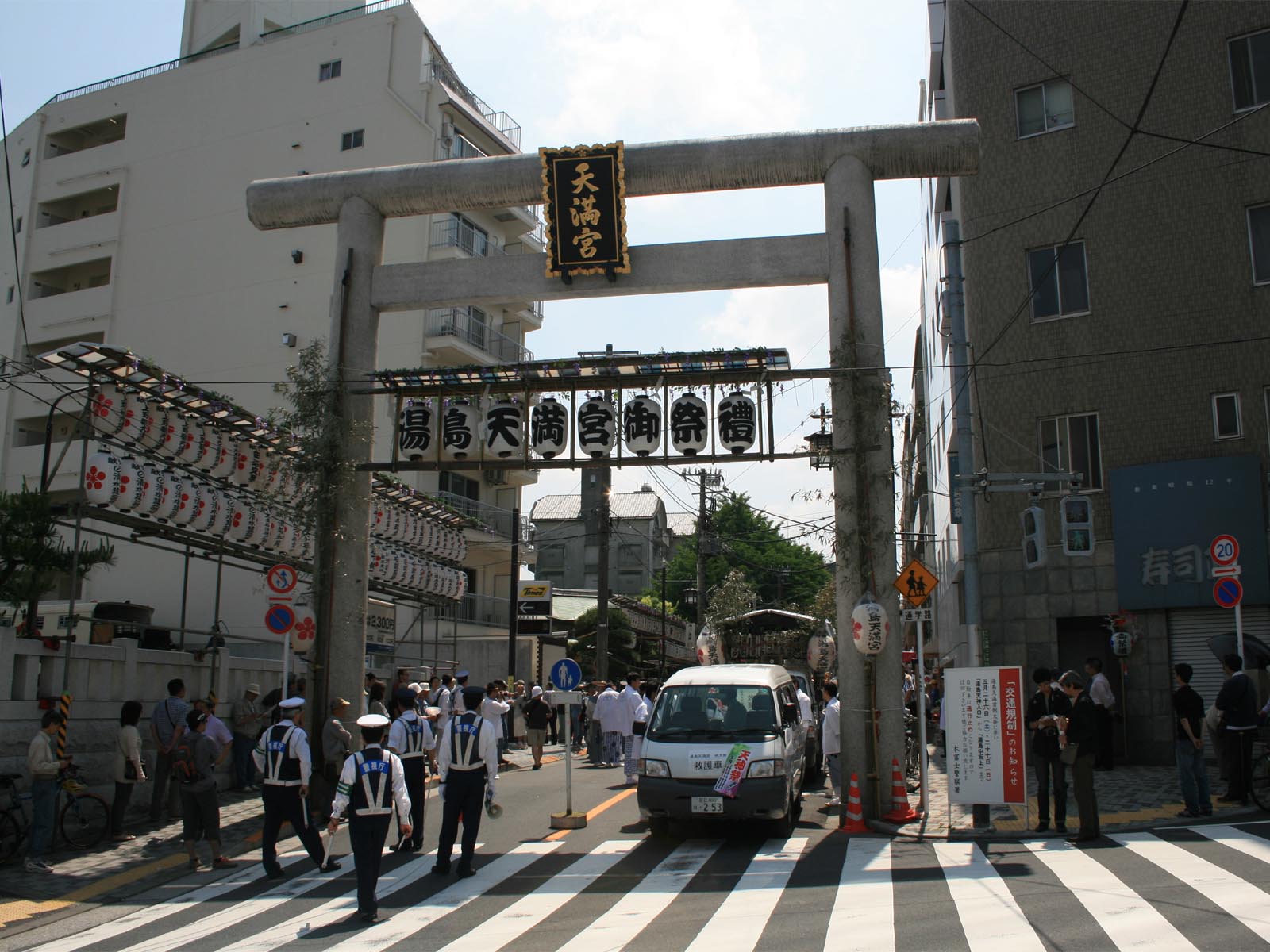
湯島天神のお祭りへ
26日、湯島天神のお祭り「天神祭」を見に行った。大学受験の時に、合格祈願のお守りでお世話になった神社ということで、一度見てみたかった。ちょうど僕が神社に着いた時、鳥居の前に神輿を担ぐ多くの人たちと馬が列を成し、まもなく出発しようとしていた。間近に馬が見られたことと、馬が神輿と共に練り歩くような本格的な「神事」といった雰囲気のお祭りに少し驚いた。参道を出るとすぐに春日通りを御徒町駅方面に向かっていった。交通量が多く、都バスも頻繁に来る春日通りを神輿や馬が歩く姿は、今まで見たことがない新しい光景だった。On 26th, I went Yushima Tenjin Shrine to see the "Tenjin-sai" annual festival.I had a lucky charm of the shrine to wish to pass the entrance test of the university, which made me go there. As I came there, the caravan of mikoshi portable shrines and horses were ready to go out. I was surprised by the atmosphere of the festival.The mikoshi and horses started to parade on Kasuga Avenue toward Okachimachi Station. I felt that the scene of the mikoshi carriers and the horses walking on a busy road, on which Toei Buses frequently come and go, looked new.
May 26, 2012
コメント(0)
-
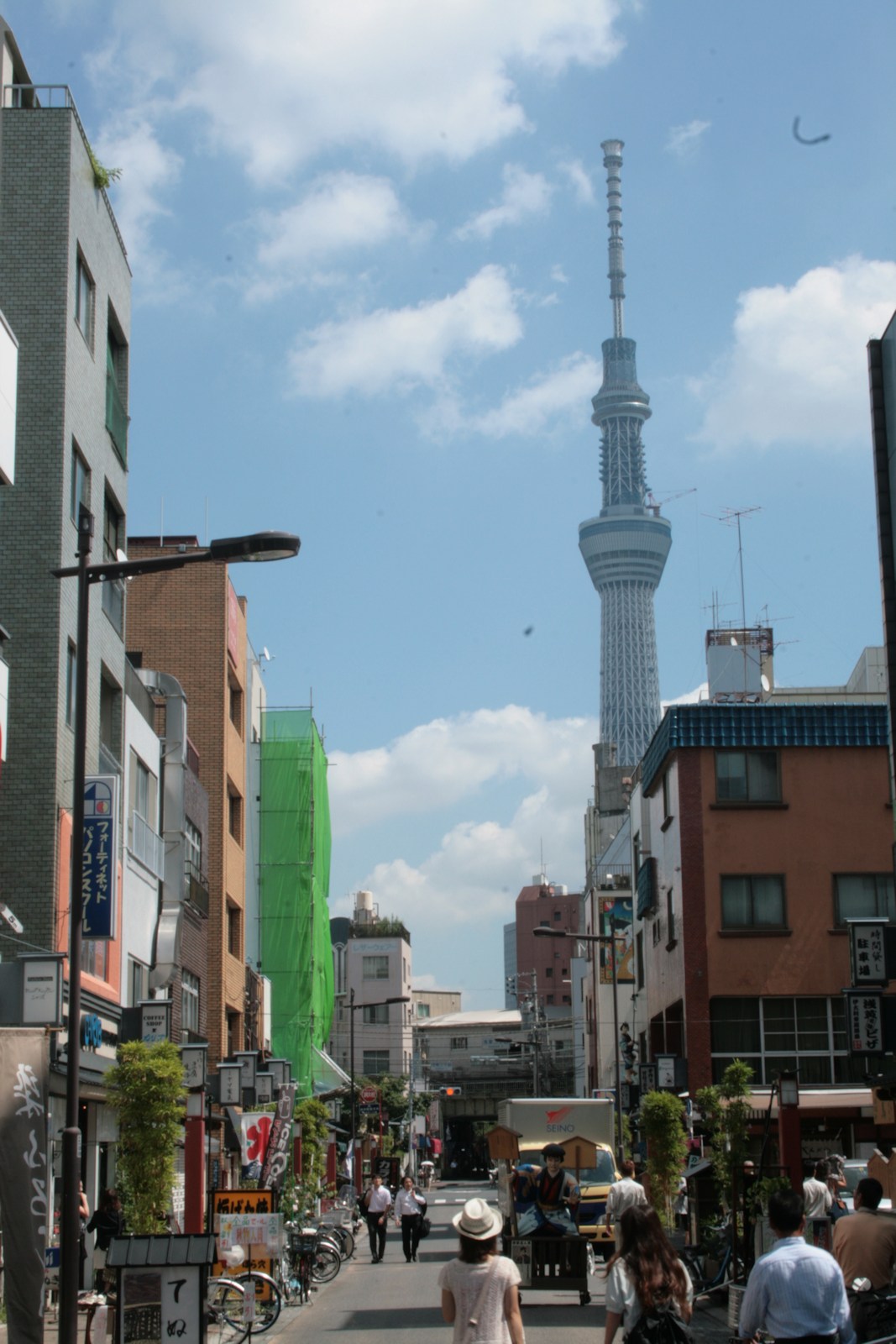
東京スカイツリーを撮る
江戸東京博物館を後にして、次は浅草へ。浅草と、対岸の押上で東京スカイツリーを撮った。浅草の街から見る From Asakusa隅田公園から 隅田川水上バスと共に From Sumida Park with a ship on Sumida River枕橋から 東武伊勢崎線の列車と共に From Makurabashi bridge with Tobu Isesaki Line今年3月に634mの高さに到達し、オープンも来年5月22日に決定した東京スカイツリー。オープンしたら、僕も展望台に上って東京の景色を眺めたい。Going out of Edo Tokyo Museum, I went Asakusa and Oshiage to see Tokyo SkyTree. Tokyo Sky Tree reached the target height of 634 metres and is going to open May 22nd, 2012. I really want to go up to its observation lounge and see the view of Tokyo.
Sep 7, 2011
コメント(0)
-

青葉城跡公園から仙台の街を臨む
仙石線の旅を終え、あおば通駅で降りた後は、やはりここを訪れる以外ないだろう。仙台の名所中の名所、青葉城跡公園だ。あおば通駅から青葉通りを歩き、青葉城へと向かう。時間がちょうどよかったから、市内観光バス「るーぷる仙台」に乗って行くことにした。青葉通りをまっすぐ歩いていけば青葉城に行けるのだが、せっかく来たのだから、ちょっと遠回りのルートになるが「るーぷる仙台」に乗ることにした。仙台の絶景 The view of Sendai from Aoba Castle Park仙台のヒーロー 「独眼竜」伊達政宗の銅像 The statue of hero in Sendai "One-eyed Dragon" Masamune Date公園近くを流れる仙台の清流 広瀬川 The limpid stream in Sendai Hirose River青葉通りでは只今新しい地下鉄、仙台市地下鉄東西線が建設中 Aoba Dori Avenue under construction東西線が開通したらまた仙台へ行きたい。Coming back to Aoba-dori Station, I visited the most famous site, Aoba Castle Park.From the station, I could catch the sightseeing bus "Rouple Sendai" toward the castle. Though people can reach the castle by walking straight along the avenue, I caught the bus running on circuitous route due to my first visit. On Aoba Dori Avenue, the new underground train, Tozai Line, is under construction. I want to go there after the new train open.
Sep 6, 2010
コメント(0)
-
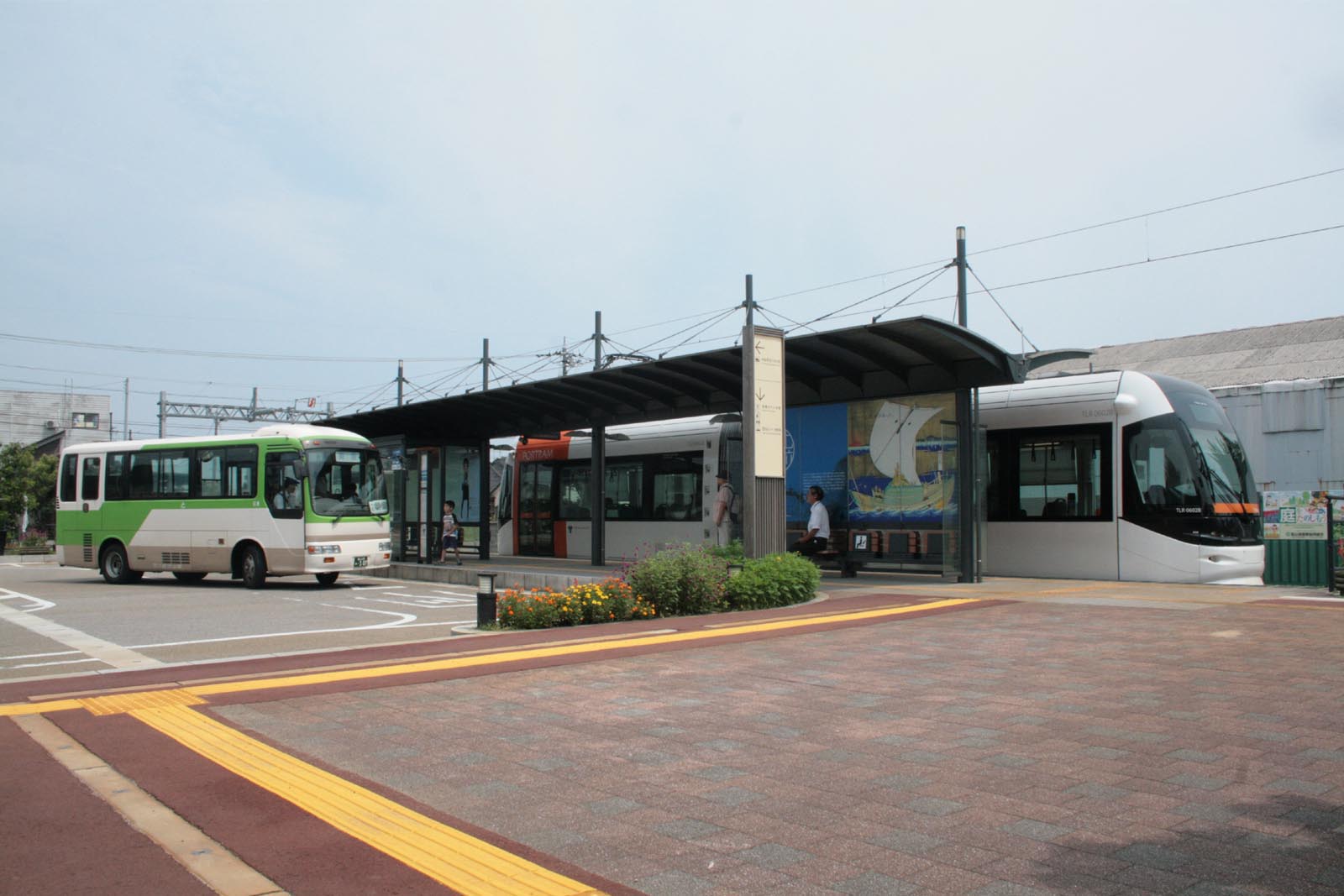
北前船の寄港地・岩瀬を行く
富山ライトレール富山港線の終点、岩瀬浜電停から2つ手前の東岩瀬電停までに広がる岩瀬の街を見てきた。岩瀬浜電停に着いたときは雨は小降りだったものの風が強く傘が差そうに差せなかった。電停から南に向かって歩き、橋を渡って岩瀬運河沿いに富山港方面に向う。道なりに左に曲がり灯台を前に見えたらその手前、2つめの角で左の細い道に入る。するとすぐに明治時代の趣ある街並みが広がる。ここが明治時代の廻船問屋が軒を連ねる大町通り。ここに並ぶ廻船問屋の中で、特に有名な森家を僕は見てきた。森家は1878(明治11)年に建てられ、現在は国の重要文化財に指定されている。中には北前船の模型や江戸後期~明治にかけての北前船や岩瀬の歴史資料などが展示されている。森家を見終わった頃には雨は止み、このまま東岩瀬電停まで歩いて再び富山港線に乗った。I walked around Iwase town spreading between Iwasehama Tram Stop and Higashi-iwase Stop.As I came to Iwasehama, it was drizzling and windy. I tried to open my umbrella, but it almost blew away. Going toward south from the tram stop, over a bridge, and along Iwase canal toward Toyama port, a lighthouse stands on the left. Turning left at a corner before the lighthouse, I came to the street with an atmosphere in Meiji period, Omachi-dori. Some shipping agents for Kitamae-bune. I visited an old house of Mori, the most famous shipping agent in Iwase. In this house, some models of Kitamae-bune and historical materials are shown.As I went out of the house it stopped raining and I went to Higahsi-iwase Stop to restart the travel by Toyamako Line again.
Mar 22, 2009
コメント(0)
-

「千と千尋の神隠し」を想像させる日本列島総鎮守 生島足島神社
途中の下之郷で降り、歩くこと5分ほど、生島足島神社へ行って来た。この生島足島神社は、日本国土生成の霊であり、日本のすべての生命の発展と繁栄を司る神様、生島様と足島様が祀られ、日本列島の総鎮守とされる。戦国時代には武田信玄が戦の必勝祈願をした神社だ。近年は、宮崎駿監督の映画「千と千尋の神隠し」を想像させる神社として地元紙に紹介された。この映画の主人公・荻野千尋ちゃんが銭婆に会いに行く時、電車に乗って6番目の駅「沼の底」で降りた。別所線で別所温泉から6番目の駅が生島様と足島様が祀られている生島足島神社の最寄り駅である下之郷駅。ここから千尋ちゃんが乗った電車が別所線を想像させると言えるうえに、その昔塩田平は湖の底だったという伝説があることから、6番目の駅である沼の底が下之郷駅だと言えよう。映画に登場する銭婆と湯婆婆の姉妹が生島様と足島様を、ハクが化けた白い竜が塩田平の民話に登場する竜を想像させ、油屋のモデルになった建物の1つも別所温泉の旅館だと言われている。I dropped in Shimonogo to visited Ikushima-tarushima Shrine. Ikushima and Tarushima, who create the Japanese Islands and prosperity of all existence, are enshrined. In the Age of Civil Wars Shingen Takeda prayed for his win.In recent years, the shrine appeared on the local paper as that looking like the one in a Japanese movie, "Spirited Away". The heroine of this work, Chihiro Ogino, travelled on a train and got off at 6th station "Numanosoko" from the bathhouse to meet Zeniba. On Bessho Line the 6th station from Bessho-onsen is Shimonogo. Moreover, it is said that Shioda basin was under the water. These are the reason that we can say the model of the train on this movie is Bessho Line and the one of Numanosoko is Shimonogo. It also said that the image of Zeniba and Yubaba is Ikushima and Tarushima, the one of white dragon taking the shape of Haku is the dragon appeared on the folktale, and one of the models of the bathhouse is an inn in Bessho.上田市役所 - 「千と千尋」と塩田平
Mar 20, 2009
コメント(0)
-
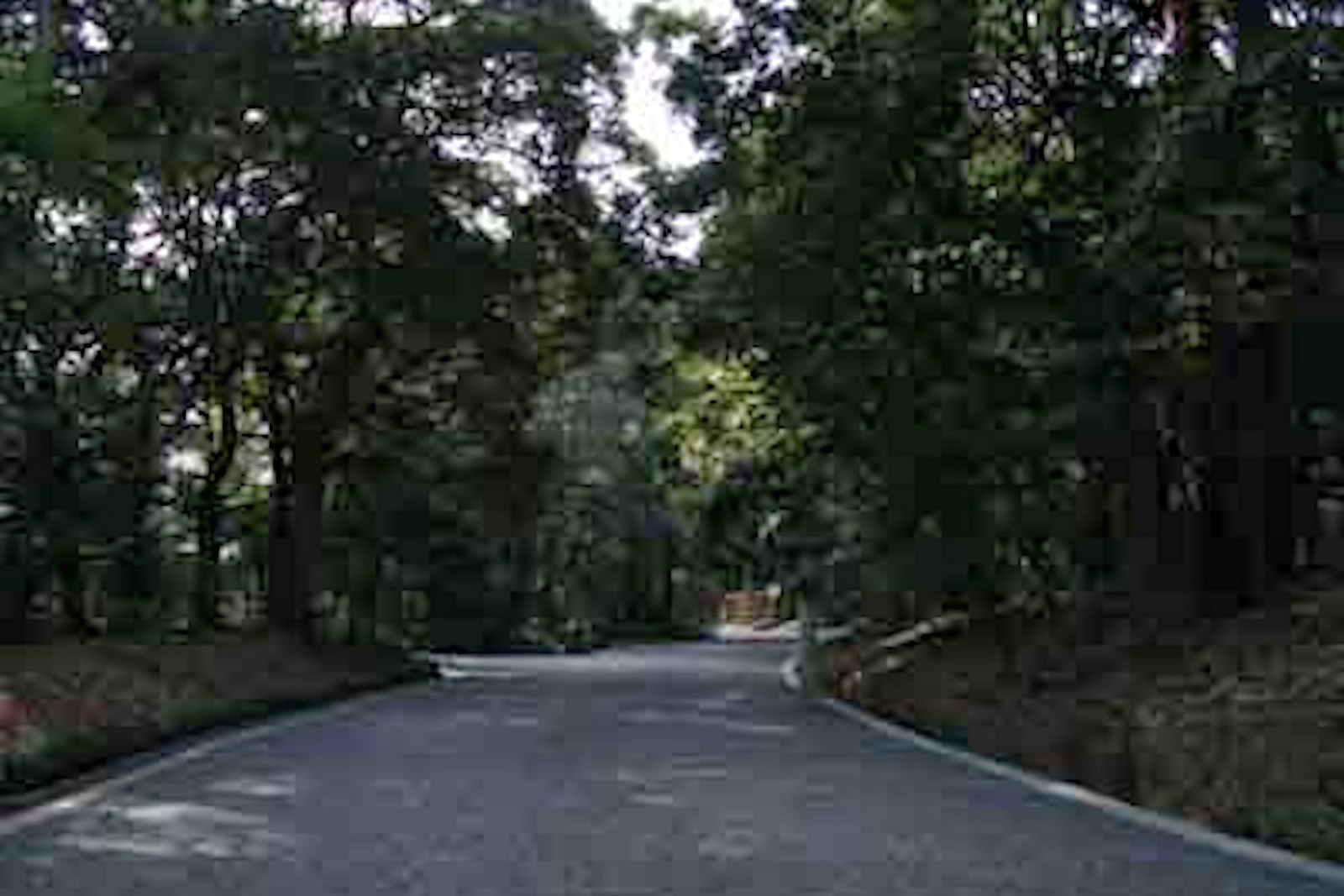
明治神宮を歩く
都営まるごときっぷを使って都内めぐり。明治神宮をお参りした。実は僕が明治神宮を参拝するのはこれが初めてだ。明治神宮は1920(大正9)年に明治天皇と昭憲皇太后を祭る神社として創建、現在では正月三が日の初詣客の数は日本一となり、「東京の神社」の代表格となっている。代々木駅、北参道駅からは北参道を歩いて社殿へと向かう。参道はたくさんの木が包み込み、都会のオアシスという言葉がぴったりだ。これが大鳥居。丁度代々木からの北参道と原宿からの南参道との境目、内苑の中間点に位置している。手水舎で手を清めた後、もう1つ鳥居をくぐる。その奥に社殿がある。社殿の前の広場は、1月の横綱の奉納土俵入りで有名。I travelled in Tokyo with "Toei Marugoto Ticket" and visited Meiji Shrine first time.Meiji Shrine is built in 1920 where Emperor Meiji and his wife, Empress Shoken, are enshrined. On new year's day, about 3 million visitors go there and the number of visitors is the highest in Japan. It can be said the most famous shrine in Tokyo.From Yoyogi Station, or Kita-sando Stations, we walk on the north approach to Ootorii (The main entrance). The approach is surrounded by trees and we can say this shrine the oasisin Tokyo metropolitan area.This is the Ootorii. It is at the centre of the ground and the border of 2 approaches from Yoyogi and the one from Harajuku.After washing our hands, There's the other torii in front of the main shrine. The open space in front of the front shrine is famous for the new-year ceremony of sumo wrestlers.
Feb 19, 2009
コメント(0)
-
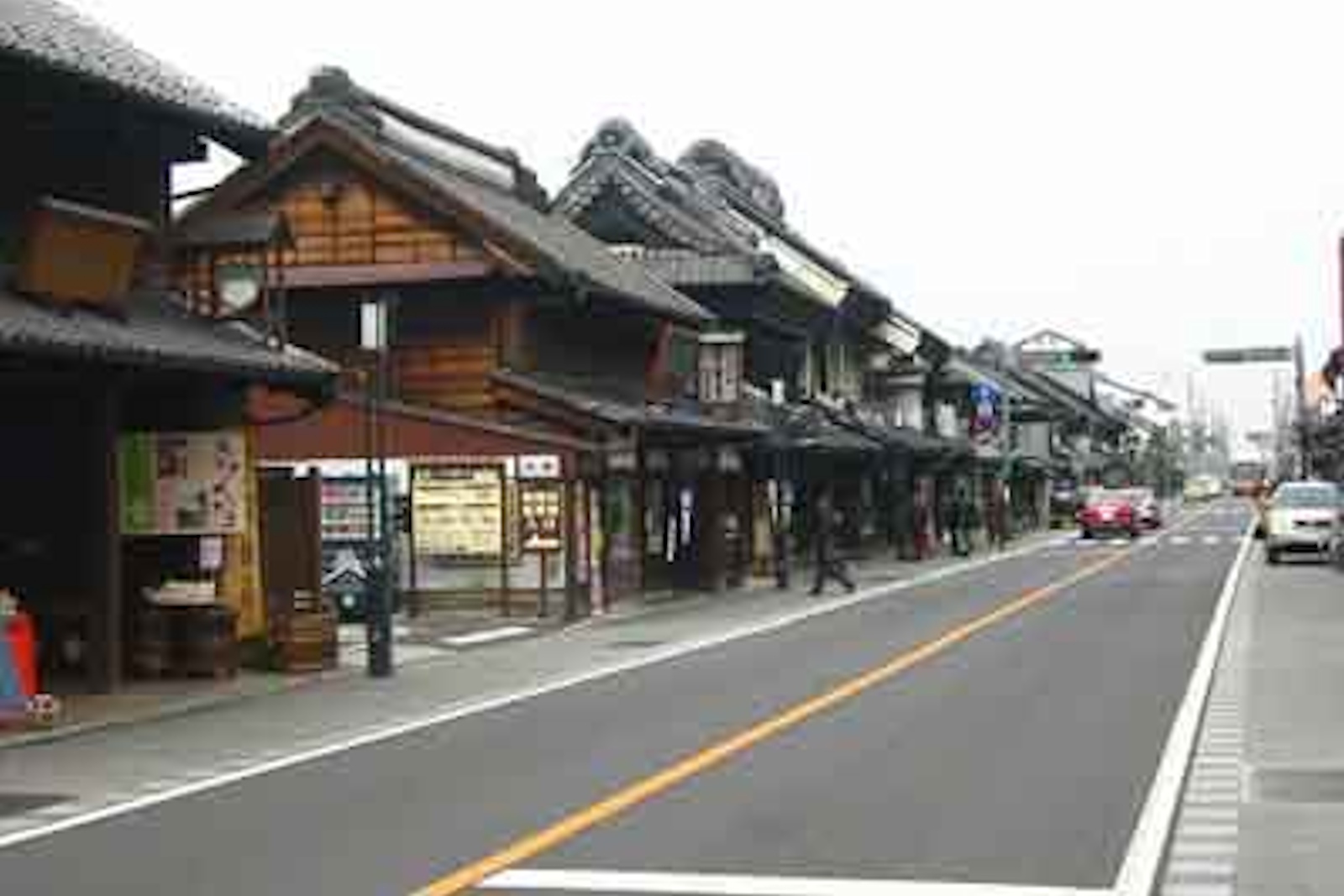
小江戸川越神社めぐり
川越の神社をお参りしてきた。川越は蔵造りの街並みや時の鐘で有名な「小江戸」と呼ばれる街である。1座目は、西武新宿線本川越駅から蔵造りの街並みへ行く途中にある熊野神社。毎年12月3日に酉の市が開かれ、2007(平成19)年に「川越銭洗弁財天」が再興した。2座目は川越氷川神社。川越の神社では最も有名なのがここ。縁結びの神様をお祭りしており、参拝客が多い。毎年10月の川越の風物詩、川越まつりはここの神社の例祭。最後は三芳野神社。「横断歩道のメロディ」としてもおなじみの童謡「とおりゃんせ」発祥の地とされ、「わらべ唄発祥の所」の碑がある。I visited some shrines in Kawagoe.Kawagoe is famous for classical structures and "The Bell of Time", and is called "Koedo" because of a classical atmosphere.On the way to classic structures area from Hon-kawagoe Station, there's Kumano Shrine. On every December 3rd, Torinoichi fare is held and a small pond washing coin was built.Next, I went to Hikawa Shrine, which is the most famous one in Kawagoe. This shrine has many visitors because the god of marriage is enshrined. The annual festival is also famous as Kawagoe Matsuri.The last one is Miyoshino Shrine. This shrine is said that the origin of a Japanese children's song "Toryanse", which is also known as the crosswalk/zebra crossing melody in Japan. The monument of this song is in this shrine.
Feb 5, 2009
コメント(0)
全41件 (41件中 1-41件目)
1
-
-

- GUNの世界
- GM-7.5 COLT'S MK Ⅳ SERIES ’70 Easy…
- (2024-11-11 16:57:44)
-
-
-

- 鉄道
- 【2024/10/28】京王電鉄 京王線 87…
- (2024-11-12 21:40:08)
-
-
-
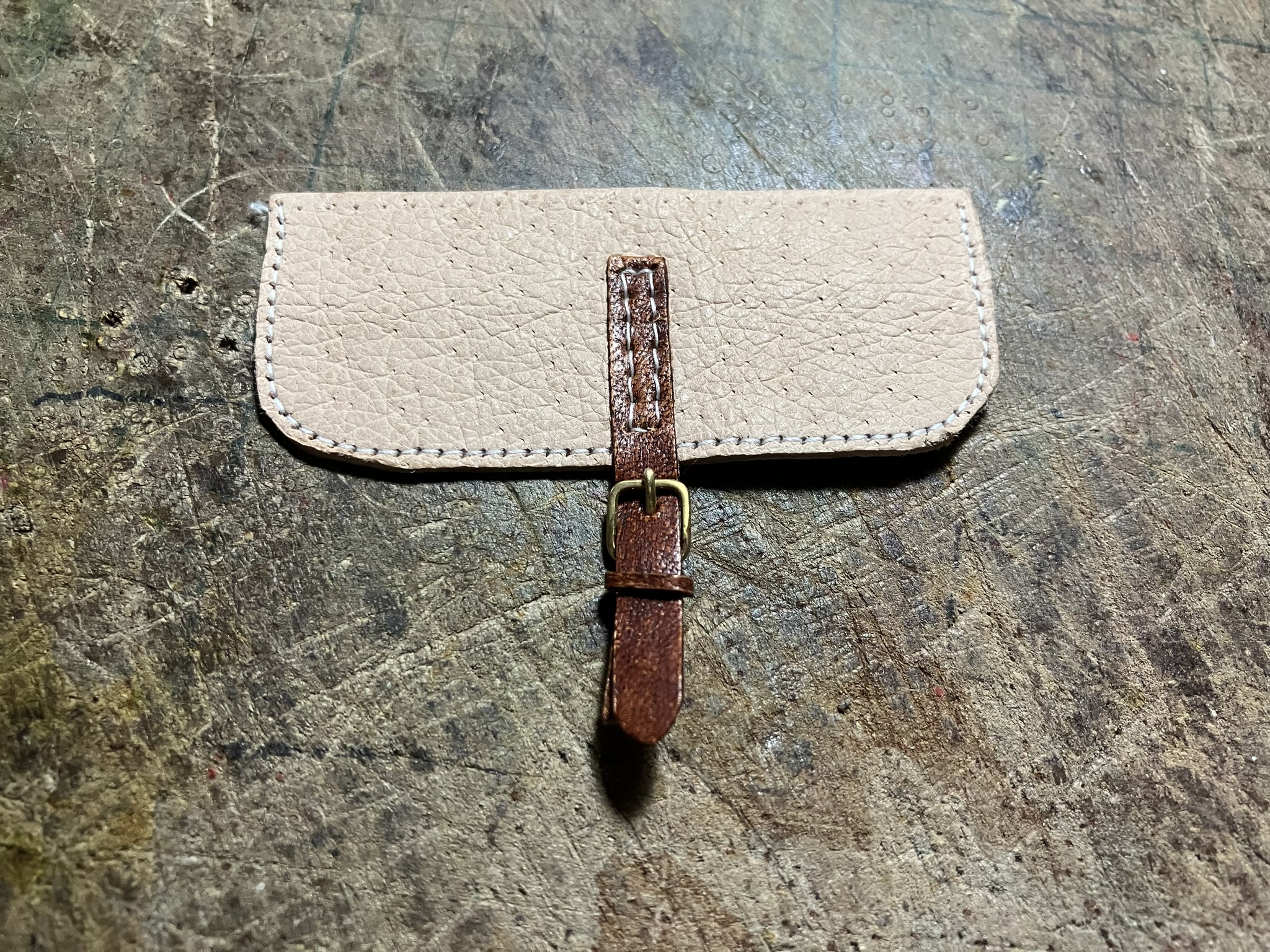
- 何か手作りしてますか?
- ペンギンの革人形を作る その199
- (2024-11-12 19:40:02)
-






